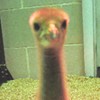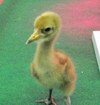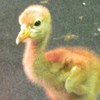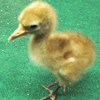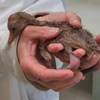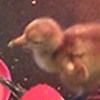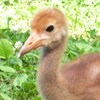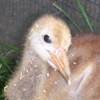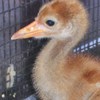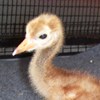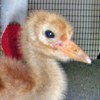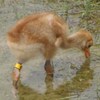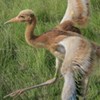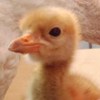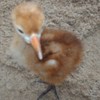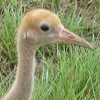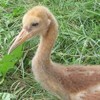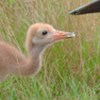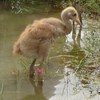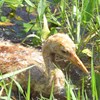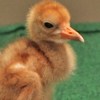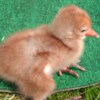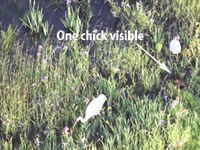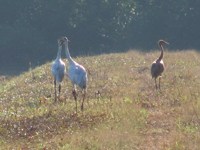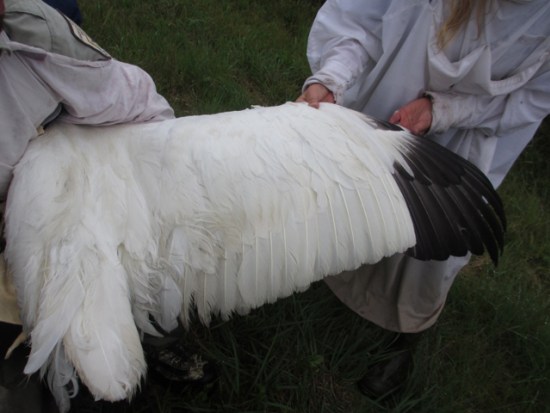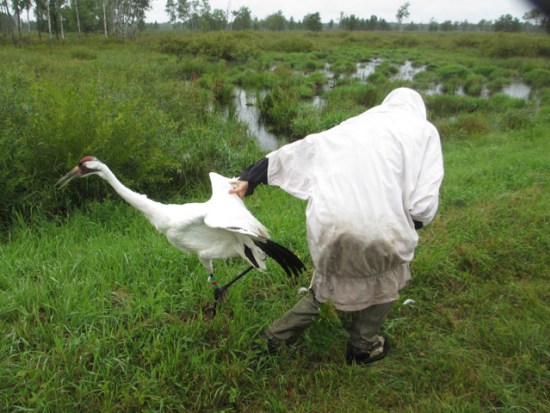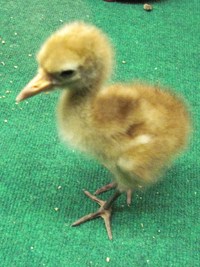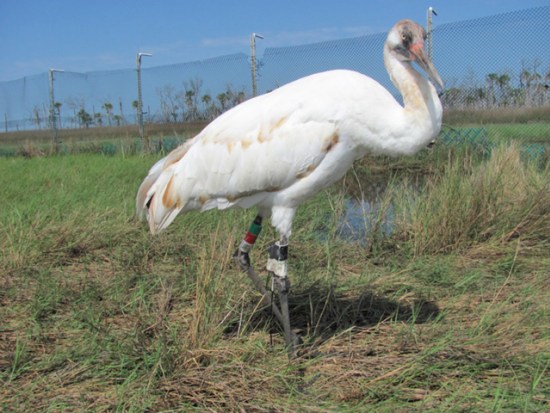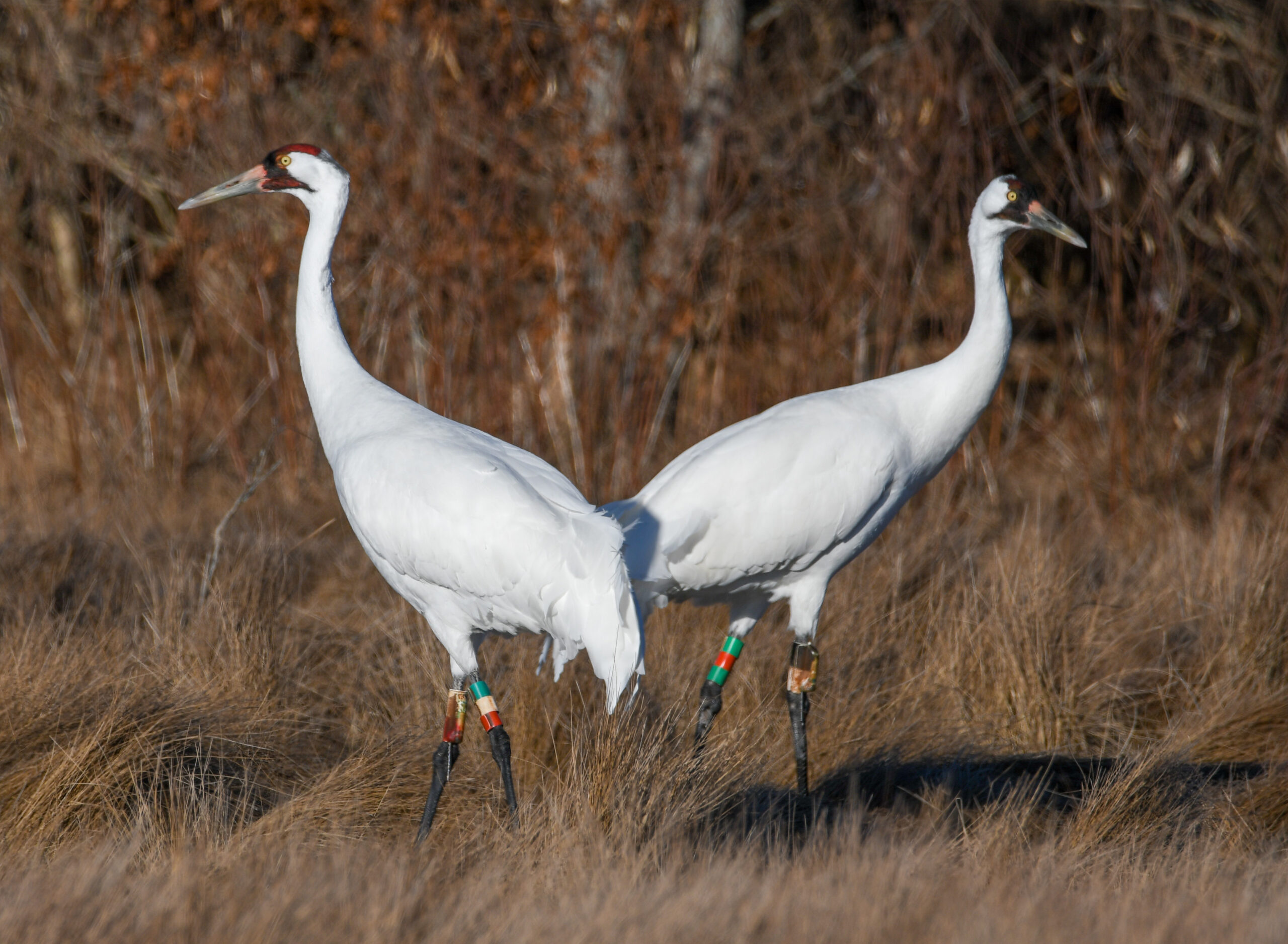Two release methods were used in 2010: Ultralight-guided (Group One) and Direct Autumn Release (Group Two). Group Three includes any successfully fledged wild-hatched Whooping Cranes in the Eastern Migratory Population!
All Whooping Cranes released in 2010 under the aircraft-guided method learned a migration route by following Operation Migration’s aircraft from Necedah National Wildlife Refuge in Juneau County, Wisconsin to St. Marks National Wildlife Refuge in Wakulla County, Florida and Chassahowitzka National Wildlife Refuge in Citrus County, Florida.
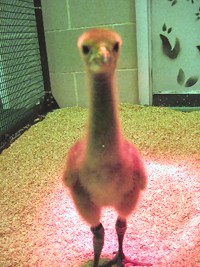
Crane #1-10
Sex: Male
Hatch Date: May 1, 2010
Personality and Characteristics: “You’d think he’s the most independent bird of the flock since he’s the oldest, said Geoff of the little chick #1-10. “But whenever we go into the pen, he’s usually one of the first to come and greet us (in our costumes).
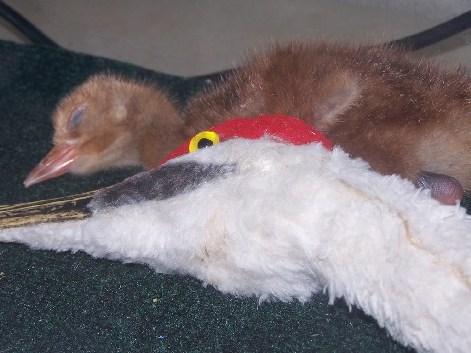
This is a photo of #1-10 when he was just hours old.
He’s also one of the first to get out of the pen and one of the first to go back in. I’d say he’s a well-trained, even polite as far as chicks go. And he’s always curious as to what the costume is doing. He’s always pecking at the costume (with me or someone else inside it!), as we sweep up food or reload feeders.”
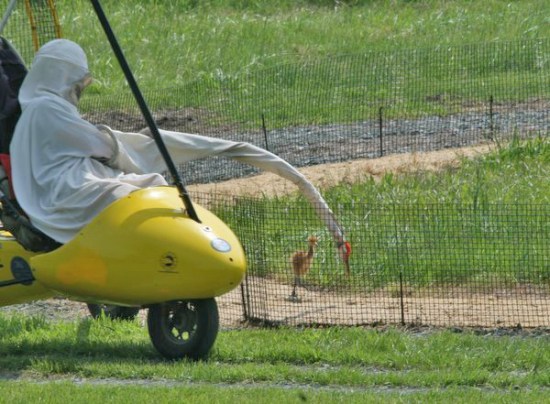
Circle-Pen Training with chick #1-10. Photo: Joe Duff, Operation Migration
Notes from “Flight School” at Necedah NWR in Wisconsin: Chick #1-10 was flown to Wisconsin for flight school with other Cohort #1 chicks on June 30 when he was 60 days old.
During the training session on June 8 he paid good attention to the ultralight plane “parent,” even though two adult whooping cranes joined in the group chasing down the runway with the ultralight. By early July he was getting close to getting a few feet off the ground. On August 3 he and his buddies #2-10 and #3-10 flew around with the ultralight plane in a big circle!
On August 12 he broke the freshwater hose in the tub and water flowed everywhere!
When the two cohorts and all 13 birds mixed together the first few times, even big #1-10 ran away from aggressive female #16-10! Crane #1-10 is and always was one of the top birds in the pecking order, but both #16-10 and #17-10 can be some seriously scary birds.
On September 26 the training session was nearly perfect, with all birds launching with Brooke. But then #1-10 and #2-10 broke away from the flight and flew back towards the pen. The rest stayed with the trike for more than half an hour before landing right where they began. But #1-10 has a habit, along with #5-10 and #9-10, of flying a single lap then landing on the runway. That needs to change!
First Migration South, Led by Ultralight Airplane: Chick #1-10 left Necedah NWR on his first migration on October 10, 2010. He was one of seven in the Class of 2010 to take off with Richard’s ultralight and one of only four to go the whole 23-mile distance on Day 1. Find day-by-day news about the flock’s migration and read more about #1-10 below.
Oct. 17: Crane #1-10 was a loyal follower of the trike that led him from takeoff. Pilot Joe Duff said, “Numbers 1-10 and 17-10 locked onto my wing and the farther we went, the more faithful they became. Brooke and Richard struggled with the rest.”
All Days: This male is a loyal and dependable follower on every flight!
Dec. 10: After today’s final flight with the Class of 2010 in one large group, this high-performance crane was put into the pen with the four other birds headed to a winter home at St. Marks NWR. Crane #1-10’s next flight will complete his first migration!
First Winter, Release Site at St. Marks NWR: The St. Marks Five had been banded and got health checks soon after arrival. The top net was removed from their pen and they were set free to come and go on Dec. 25, 2010!
Crane #1-10 has taken up the job of protecting the feed buckets at the release pen. Brooke, who is watching over the cranes during their “soft release,” said #1-10 is not shy about chasing after visiting crane #15-09 or any of the other visiting adults when they try to get near the the chicks’ food. Brooke gave #1-10 a part-time job: When the adults drop in, the costumes walk #1-10 over to guard one feed bucket and they stand in front of the other feed buckets. This means no free meals for any of the older birds. They need to go away and get their own territories and their own food!
Spring 2011, First Unassisted Migration: On March 21, males #1-10 and #8-10 departed on migration along with the two older birds (#25-09 and #29-09) that had been staying at the pen site for much of the winter! Data from their GPS transmitters indicated that they made it to Macon County, Alabama, nearly 200 miles to the north and right on course. GPS data from #1-10 indicates that, on the night of March 24th, he had made it to Jackson County, AL in the northeast portion of the state. That all adds up to 586 kilometers. March 26th his signal was picked up in Barron County, Kentucky. The next reading shows him south of Chicago near the Indiana-Illinois border. He completed migration with classmate #8-10 by the night of April 7. They wandered after they returned. They were near Zumbrota (Goodhue County, Minnesota) through at least May 17. PTT readings indicated a roost location on the southern pools of Necedah NWR on the night of May 19. By the night of May 21 they had returned to Minnesota, this time west of Dennison (Rice County). They remained at this location at least through the end of May.
Fall 2011: Crane #1-10 migrated to Greene County, Indiana for the winter.
Spring 2012: Returned to Wood and then Juneau County, WI
Fall/Winter 2012: Flew south to Lawrence County, Illinois and spent the winter between this location and Goose Pond in Greene County, Indiana.
Spring 2013: Crane #1-10, with #W1-10, was reported back on Necedah NWR on March 23, reported ICF’s Eva Szyszkoski.
Fall 2013: Male #1-10 wintered in the area of Hopkins County, Kentucky with #34-09 (DAR) and several other cranes in the Eastern Migratory Flock.
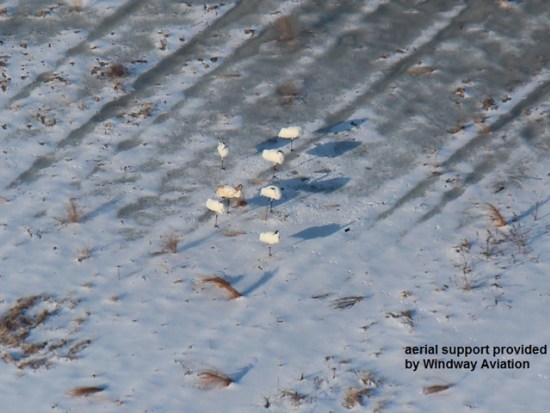
ICF tracker Eva took this photo on February 12, 2014:
Spring 2014: Cranes #1-10/#34-09 DAR along with #24-09 and #42-09 DAR began migration from their wintering area in Hopkins County, Kentucky, on 22-24 March. They arrived in Stephenson County, Illinois, by roost on 26 March and completed migration to Wisconsin on 29/30 March. He left his mate #34-09 DAR to pair up instead with female #W1-06. The new pair nested, and the nest was still active when checked on April 30. In May the pair hatched a chick! The status was uncertain as of the May 29 aerial survey flight, however, as neither parents nor chick could not be found, although a radio signal was being detected.
Fall 2014: Male #1-10 was captured and given a new transmitter/colors on the right leg on September 12 before migration. He migrated south to Hopkins County, Kentucky, where he was associating with #W1-06 and several other Whooping Cranes during the winter.
“Captures are not only for transmitter replacements,” explains ICF’s Eva Szyszkoski. “When the cranes are in hand we are able to perform a brief health exam, including checking the condition of the wing feathers. This helps us get a better understanding if the bird has recently molted or not. Birds with clean, intact feathers may have molted that year while birds with ratty, dirty feathers probably have not. Whooping cranes do a complete molt every 2-3 years, meaning that they lose all their flight feathers all at once. This is a dangerous time for them since they are completely flightless for about 6 weeks. They need to be in an area with stable water conditions so they can remain safe from predators.” Eva took these photos of #1-10’s right wing and his release after the banding and health check.
Spring 2015: Male #1-10 and female #W1-06 were seen back on Wisconsin territory during the March 25 aerial survey by Bev Paulan, DNR pilot. The pair nested, but the nest failed April 30, and they did not re-nest.
Spring 2016: Crane #1-10 and mate #W1-06 migrated back to their Wisconsin territory and were seen on a nest during the May 19 and June 3 aerial surveys by Bev Paulan, DNR pilot. Their new chicks, #W16-16 and #W17-16, were first seen on June 2 and June 5 respectively, but neither chick survived into the summer.
Fall 2016: Pair #1-10 and #W1-06 were still in Juneau County, WI as of Nov. 25 but migrated in December to Greene County, Indiana for the winter.
Spring 2017: Pair #1-10 and #W1-06 were back in Wisconsin and nesting by early April. The pair re-nested and were incubating their second nest when seen on Bev Paulan’s May 12 flight.
Fall 2017: 1-10 and W1-06 migrated to their usual winter spot at Goose Pond, Indiana in early November.
Spring 2018: The pair migrated back to Necedah Wildlife Refuge in mid-March and nested. Unfortunately, their nest was abandoned in the late April snowstorms. They did not renest.
Fall 2018: In early November, 1-10 and W1-06 were spotted at their usual wintering grounds at Goose Pond-06 Fish and Wildlife Area in Indiana.
In February, 1-10 was captured by biologists at the International Crane Foundation and the Indiana DNR. He was given a new radio transmitter which will help scientists track him in the future!
Spring 2019: Trackers confirmed 1-10 and W1-06 had returned to their Necedah NWR territory by early April. 1-10 and W1-06 were first seen nesting on April 8. The eggs from their first nest were removed for the forced renesting program.
The pair renested in late May, but the nest failed after just a few days. Unfortunately, there will be no chicks for 1-10 and W1-06 this year.
Fall 2019: 1-10 and W1-06 were first seen at Goose Pond mid-November with a group of 8 whooping cranes. They stayed with a large group until they got back to their Spring territory.
Spring 2020: In late March, they were seen back on their territory at Necedah National Wildlife Refuge. They had a failed nest in April and then re-nested in June, hatching a chick, W17-20. W1-06 and 1-10’s chick was not seen at the beginning of July and 1-10 was found dead that same week, after not being seen on pilot Bev Paulan’s survey. The cause of death was unknown.
Click here to jump to the top of this page.
Crane #2-10
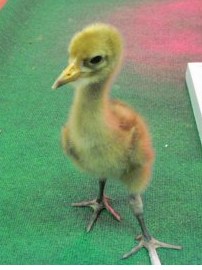
Sex: Male
Hatch Date: May 4, 2010
Personality and Characteristics: Before he was born: Chick #2-10 had already traveled many miles before hatching. A man named Dwight Knapik is the flock manager for the captive Whooping cranes at Calgary Zoo in Canada. He and other crane experts get the eggs of those cranes delivered to important Whooping crane projects. In spring 2010 Dwight carefully packed some fresh crane eggs in a portable incubator long before you were even awake. Then he spent hours getting them warmly and safely through airport security, customs officials, and traffic. He brought the eggs all the way from Calgary, Canada to Maryland, USA. The eggs were tucked into the incubator at Patuxent WRC. Those eggs hatched into chicks #2-10 and #4-10.
Chick #2-10 was six days old in the photo to the right. Always curious, he has never been afraid to try new things. He trusts the costume, but doesn’t put up with hassling from fellow chicks and isn’t afraid to get in their faces. Geoff calls #2-10 the “no nonsense” bird!
Notes from “Flight School” at Necedah NWR in Wisconsin: Arrived in Wisconsin for flight school with other Cohort #1 chicks on June 30 at 57 days old. He will live together with the other Cohort #1 chicks at the North pen until all the chicks of the Class of 2010 are later joined in one large group.
Chicks #2-10 and #3-10 started with a bad habit of refusing to come out of the wet pen (the pond inside the pen) for training. Handlers had to coax and bribe them with treats to come out, and sometimes it didn’t work. He was not too interested in flying at first. But one night Geoff put all the birds in the dry pen. With no pond to keep them happily inside, these two chicks came out to play with the trike when it appeared for training, and did great. Chicks #2-10 and #3-10 were mostly last, but they still followed the pilot in the trike. They ran behind as the trike taxied, flapping their wings and building their flight muscles, almost ready to rise a little bit off the ground. On August 3, chick #2-10 and buddies #1-10 and #3-10 flew around with the ultralight plane in a big circle.
He wasn’t terribly interested in flying at first but became more open to the idea after seeing how much fun it is!
“Says Geoff, “Chick #2-10 puts more value on his solitude and doing his own thing. And anyone who gets in the way of that has made themselves an enemy. He won’t take guff for long and is quick to throw his weight around. At Patuxent we used him to give two other chicks (including #16-10) a lesson in giving up their thuggish ways. Lately, he’s grown more attached to the costume. He will go over to greet it in the pen, rather than linger in the wet pen like he normally does.”
In late September when the two cohorts were mingled on the runway for the first few times, #2-10 held onto his undefeated title when #16-10 and #17-10 went on their rampages and tore after every bird in cohort one. Male #2 never took any guff from them before, and wasn’t going to take any guff from them now. He’s still top bird!
October 8: This take-off was meant to be the migration departure, but when they met with headwinds aloft, the pilots decided it would be too tough to lead the young birds the whole 23 miles to stopover #1. They turned it into a training flight instead. Crane #2-10 had already decided that! He dropped out not too far into the flight and returned to the pen he just left, only to be encouraged by the Swamp Monster to get airborne again. He had to be located, crated, and transported back to the pen where his flockmates had landed.
First Migration South, Led by Ultralight Airplane: Chick #2-10 left Necedah NWR on his first migration on October 10, 2010 but turned back shortly after take off. He did not fly any of the 23-mile distance on Day 1, but made the trip in a crate by road. Find day-by-day news about the flock’s migration and read more about #2-10 below.
Day 2 (Oct. 11): The birds launched with the ultralights but #2 dropped out and refused to take off again. Several others had troubles too. The pilots turned back and put the birds in their pen to try again tomorrow, weather permitting. Until #2’s wing heals, he needs to migrate in a crate. Trish and Geoff go to the pen early to put him in the crate before the pilots come. All the other chicks peep excitedly, as if to say: “Let’s go, we’re tired of standing around in this pen all day!!” But this time #2 got away from Trish before she got him in the crate: “I stayed calm and walked over towards #2 with a grape, but with his newfound freedom, he kept just ahead of me. Geoff came over to help, to no avail. If we got too close, #2 would run, flapping those beautiful wings, and cruise across the runway. With the pilots approaching, I radioed, despair in my voice, “Ground crew to Air Crew. #2 got away from me. He is not in the crate.” They finally got him, but only after the ultralights left the scene on what turned out to be a turn-back day.
Day 9 (Oct. 18): He was crated and driven to this stop yesterday because of a wing abrasion, and today crane #2-10 was one of the five birds that were late coming out of the pen. Joe flew in to pick them up. Four followed him but #2 turned away and landed away from the pen. Trish and Geoff crated #2-10 and he made the trip across the Wisconsin border by road.
Troubles? By now #2 has traveled a lot of miles by road. Worse, Geoff said, “Even with a healed-up wing he showed little interest in following the trike. Everyone including myself now suspects there may be a behavioral problem afoot. Before we left Necedah he was always low bird on the totem pole while they were in the air. It wasn’t uncommon to see him drop out and land on the runway after five or ten minutes of training. Brooke suspects he might be uneasy with flying with the trike. Considering this is the same, no-nonsense, take-crap-from-nobody bird who used to knock sense back into #11 and #16, I can’t help but be a little puzzled by that. Perhaps throwing your weight around with ten other birds isn’t so easy when you don’t have both feet on the ground. But I’m not giving up on number 2 yet. He has flown before, and we can surely make him fly again. Brooke hopes that if we can fly him by himself next time we fly, he might be more interested in staying airborne. I think that’s a swell idea, since that’s how we got him to Lasky Field back in Necedah. Maybe if he doesn’t have to worry about fighting with 10 other birds for a spot next to the trike he’ll hit his groove. If nothing else, I just hope he learned not to run and flap around the pen like a wild thing. Not unless he wants to bang that wing up again.”
Oct. 27: It has been way too windy for the team to try flying #2-10 by himself to see how he’ll do. (He would not leave the pen without all the other birds the last time they tried that.) Pilot Joe Duff is beginning to wonder if #2 has physical problem that can’t be seen, but he admits he could be wrong about that idea. If he won’t fly with the ultralight and other birds, he will have to be removed from the Class of 2010 and transferred to a zoo. If that happens, Joe will recommend that #2 be radiographed (x-rayed) to see if there is indeed a reason why he’s not flying and following like he should. At least then they would know the facts. And if no problem is revealed, he will have better chances of a long life if he’s safe in a zoo. Everyone is waiting to see what happens the next time the weather lets them fly!
Day 22, Oct. 31: Crane #2 made the journey to LaSalle County in a crate by road. But what a story! After the other ten birds had taken off, today’s plan was for Brooke to turn back and try to encourage #2-10 to fly with him. They would see if , he would be willing to follow with all his buddies gone. The team could learn if his problem was physical or psychological. That part of the plan didn’t work so well. Here’s why: It seems that overnight, or more likely, early this morning, number 2 became the target of aggression. When the ground crew showed up at the pen, he was being chased by two other birds. He was pacing to get out and abrading his wings on the fence. Running away is a submissive behavior and will only make things worse, and he was paying the price. He had a bit of blood on him and, in the bird world, that made him a target. So after an eventful morning avoiding his enemies, then being examined by handlers and subsequently pushed into a crate, #2-10 wasn’t in the mood to going flying with the trike. The team will wait and find another opportunity to test his willingness or ability to migrate.
Day 23, Nov. 1: Today is the day! At today’s takeoff, Brooke flew past with 9 cranes, followed by Richard with 2 birds. YES! Crane #2-10 is flying! Joe followed behind in the chase position, ready to lend a wing to any tired cranes. Brooke wrote: “Richard used his magic along with some of Geoff’s and Trish’s to coax #2 and #3 into the air, onto his wing and on course. He fought the battle to keep #2 airborne for over two hours when the morning’s awakening thermals rose to rough up the air.
Discouraged, #2 and #3 landed and Richard landed nearby as Walt and Ali in the tracking van pulled into view to lend assistance. Richard got #3 airborne but #2 had enough of flying for one day. Walt and Ali retrieved the little fellow and returned him to his box while Richard continued the journey.” But he made it 44.5 miles on his own! Everyone hopes the flying experience will inspire him for the next leg of the migration. Go, #2-10!
Joe later said, “I think the fact that he was alone except for his buddy, number 3 encouraged him to fly.” When he dropped out alone, he was freaked out. But for the first time Joe is optimistic that #2-10 will eventually migrate. “Knowing he can fly if he wants to might be grounds for getting him to Florida one way or another.”
Day 27, Nov. 6: Well, today he didn’t want to fly. The other ten took off with Richard. Brooke went back to see if #2 would take off and fly alone with Brooke’s ultralight, but he only wanted to go back to his pen today. He made this leg of the migration in a crate.
Exercise Day, Nov. 12: As the birds looped around the pen on this exercise day, #2-10 landed off in a nearby field and just wandered around. He had flown with the rest of the birds for no more than a minute or two before he either got tired or lost interest. Costumed Geoff went to lead him back over toward the runway. “I think he was happy to see his ‘daddy’ come get him. But I was silently wondering what happened to the #2-10 who, with buddy #3-10, left LaSalle County in the dust on a great flight.”
Geoff noticed that the birds all took off from the pen with a running start, flapping their wings. Just before they took off, they were gliding five or six feet off the ground. Bird #2-10 followed those initial two steps, but never actually got off the ground that first time. He did the same thing again once Geoff retrieved him from the bean field; he ran and flapped his wings, but without getting lift off. He flew again with the rest of birds one more time before the team put them back in the pen. But Geoff had to walk #2-10 back to the pen after he once again lost interest in flying and landed elsewhere.
Geoff wrote: “This bird’s outlook keeps getting bleaker every time we let him out of the pen. He won’t fly with the rest of the flock. Once, he got so spooked that he wouldn’t even take comfort in the costume. When we tried holding him back and flying him on his own at the last stop, he wouldn’t fly. No one wants to give up on him, including me. But he is quickly running through his options. So far, his migration route looks like the four corners on his wooden crate.” The team is “singing the #2-10 blues.” What will happen next?
Day 38, Nov. 16: The team gave #2-10 another chance to take off and follow. He surprised them when he circled around with them all a few times as they slowly gained altitude. But it didn’t last. He soon broke off and began his descent. He turned many of the birds back with him. As the pilots passed over the pen one more time, the swamp monsters discouraged any of the birds from landing.
From 100 feet above Joe collected 10 birds that were generally following #2-10 and watched as he approached a tall, leafless tree line—not good! “I was shocked when he didn’t turn away, but instead made a desperate and foolish attempt to climb,” reported Joe. “Then he hit the top branches and tumbled through like a white paper bag full of rocks. He hit the ground spread eagle as I passed over, but by the time we turned around, he was already out of sight. We found out later that he miraculously escaped injury but once again had to make the trip in a crate.” WHAT NEXT??!
Day 39, Nov. 17: Another fly day! Seven birds conformed to the order of the day while three turned back, and #2 did his usual routine: He landed in a nearby field to await later capture and his ride in the box.
Day 48, Nov. 26: #2-10 was crated prior to launch so that he wouldn’t convince the others to turn back. He was driven the 116 miles of this double-leg migration day.
Day 53, Dec. 1: Today #2-10 was transported to a Nashville veterinary clinic for an exam to see if there was a reason why he didn’t want to fly. Doctors had to follow the rules of turning off phones, removing any dogs from the clinic so they wouldn’t bark, wearing a baggy white costume and helmet, and keeping silent. But finally we know the problem: Crane #2-10 has a torn tendon in his wing. See newspaper article.
The crane experts of WCEP decided that he would be returned to U.S.G.S. Patuxent Wildlife Research Center in Maryland. Brave #2 flew only 40 miles of the more than 800 air miles logged by the Class of 2010 to their stop in Chilton County, Alabama, where he was crated for his last road trip on December 5. Brooke and Richard went out to the pen to separate #2 from his classmates. They walked him away from the pen and into the crate hidden from sight of the rest of the Class of 2010. Within minutes, Robert Doyle and Jane Chandler pulled out with #2 in the back of the U.S.G.S. Patuxent van. They drove 13 hours straight through to Laurel, Maryland and #2-10’s new home.
Click here to jump to the top of this page.
Crane #3-10

Sex: Female
Hatch Date: May 4, 2010
Personality and Characteristics: At first chick #3-10 could be pretty aggressive towards specific birds. When being socialized with #4-10, chick #3-10 took shots at her whenever the two females got close enough. But she got it out of her system and soon #3-10 and #4-10 lived together in the same outdoor pen. They trained together too.
Notes from “Flight School” at Necedah NWR in Wisconsin: Arrived in Wisconsin for flight school with other Cohort #1 chicks on June 30 at 57 days of age.
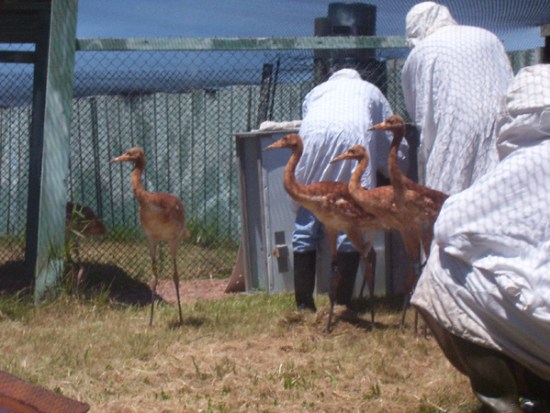
Welcome to Wisconsin! Photo: Geoff Tarbox
“I think she might be a little snobby,” said Geoff. “Like #2-10, she’s usually off doing her own thing whenever she has company. But she’s not quite as willing to listen to the costume as #2-10 is.”
Chicks #3-10 and #2-10 started with a bad habit of refusing to come out of the wet pen (pond inside the pen) for training. Handlers had to coax and bribe them with treats to come out. Chicks #2-10 and #3-10 were mostly last, but they still followed the trike (ultralight plane). They ran after the trike, flapping their wings and building their flight muscles, and on August 3 she and her buddies #1-10 and #2-10 flew around with the ultralight plane in a big circle!
Chick #3-10 prefers to do things at her own pace. She’ll come back into the pen after training whenever she feels like it. “She likes to throw her weight around too,” said Geoff, “but I don’t think she has as much clout as #2-10 does. I think being one of the first to fly has gone to her head.”
She has always been high on the pecking order. When the younger chicks and older chicks began to mix together under the watchful eyes of the costumes, #3-10 acted tough. She jumped high and her sharp, long claws got very close to another chick. The other chick backed down. So #3-10 started on a different chick, jumping up as if to say, “Oh yeah? That’s what YOU think! Check out these claws, pal.”
Oct. 7: Somehow, #3-10 escaped the enclosure in the darkness of early morning. Luckily, Heather was watching the CraneCam from her computer in Canada. “The way it was acting—pacing outside in the darkness—told me it might be a chick and not one of the adults who like to visit the pen.” She phoned to alert the team and Joe and another costume went out and let the wayward colt back in the pen. It turned out to be #3-10!
First Migration South, Led by Ultralight Airplane: Chick #3-10 left Necedah NWR on her first migration on October 10, 2010. She was one of seven in the Class of 2010 to take off with Richard’s ultralight and one of only four to go the whole 23-mile distance on Day 1. Find day-by-day news about the flock’s migration and read more about #3-10 below.
Day 23, Nov. 1: Brooke wrote: “Richard used his magic along with some of Geoff’s and Trish’s to coax #2-10 and #3-10 into the air, onto his wing and on course.” They’d been airborne for over two hours when the morning’s awakening thermals rose to rough up the air. Discouraged, #2-10 and #3-10 landed and Richard landed nearby. Richard got #3-10 airborne again and together they flew the rest of way. What a star!
Day 63, Dec. 11: Yesterday was the last time all ten birds will fly together as a group. Today #3-10 and the other four birds that will winter at Chassahowitzka NWR flew 86 miles closer to their final destination! They’re now in Gilchrist County, FL. Only 86 miles and two flights to go. [But they would have to wait for their next flight until January 14, 2011 due to reason’s beyond the team’s control.]
Day 72, Jan. 14: Finally in the air again! After so many days in the pen, the Chass Five gave pilots Joe and Richard a rodeo before they got on course to Marion County and the flyover arrival celebration. One more flight gets them to their winter home!
Day 73, Jan. 15: Migration to Chassahowitzka NWR complete!
Winter at the Chass Release Pen: Of the five Chass youngsters, female #3-10 is the lowest in the totem pole, reports Eva. “She is very shy around the other birds and tries to stick close to the costume when it’s near…maybe looking for an extra grape or two before the others grab them all!”
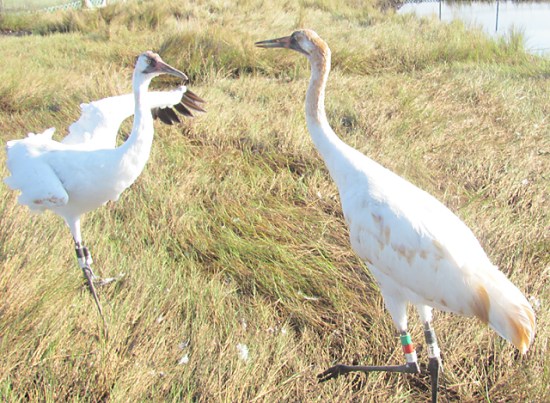
Female #3-10 gets put in her place by male #17-10. Photo: Eva Szyszkoski
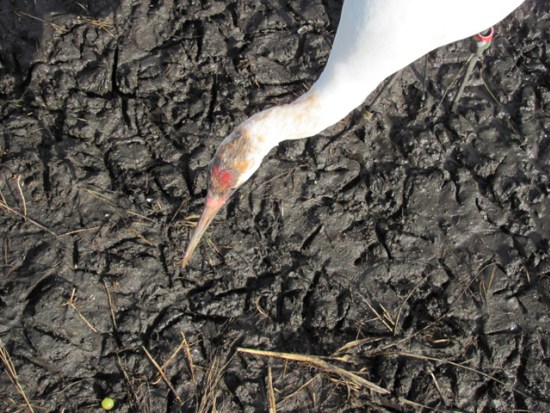
What has 3-10 found? and look at the red coming in on her head. Photo: Eva Szyszkoski
Spring 2011: On the first day of spring, Eva reported: #3-10 has an incredibly large red patch already and barely any brown feathers left at all!” She began migration on April 4 from the Florida pen site with flock mates #9-10 and #17-10! The PTT that night fired off from Terrell Co, GA which is about 240 miles from Chass. The second stop (night of 5 April) was in Alabama, about 100 miles NW of their first stop. After further stops in Clark County, IN, Livingston County, IL and Lee County, IL, Cranes #3-10, #9-10 and #17-10 were confirmed —still together —at their 6th migration stop (Sauk County, Wisconsin) on April 15. They moved a little south again before officially completing migration.
Fall 2011: Crane #3-10 wintered in Marion County, Florida.
Spring 2012: She has not been detected since Feb. 22, when she was still on her wintering ground in Marion County, Florida.
Click here to jump to the top of this page.
Crane #4-10
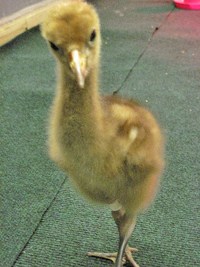
Sex: Female
Hatch Date: May 5, 2010
Personality and Characteristics: At first chick #4-10 got picked on by older female chick #3-10. But before long the older chick stopped it and soon #3-10 and #4-10 lived together in the same outdoor pen. They became training partners and got along just great. She did not travel to Wisconsin for flight school with other Cohort #1 chicks on June 30 because she was healing from a sudden infection. She was not yet well enough to go on July 9 when the cohort #2 chicks made the airplane trip to Necedah NWR. Experts hoped she will get well and come later to be part of the Class of 2010—and she did!
Before she was born: Chick #4-10 had already traveled many miles before hatching. A man named Dwight is the flock manager for the captive Whooping cranes at Calgary Zoo in Canada. He and other crane experts get the eggs of those cranes delivered to important Whooping crane projects. In spring 2010 Dwight carefully packed some fresh crane eggs in a portable incubator long before you were even awake. Then he spent hours getting them warmly and safely through airport security, customs officials, and traffic. He brought the eggs all the way from Calgary, Canada to Maryland, USA. The eggs were tucked into the incubator at Patuxent WRC. Those eggs hatched into chicks #2-10 and #4-10. They were later joined by #10-10 and #12-10, also from Calgary.
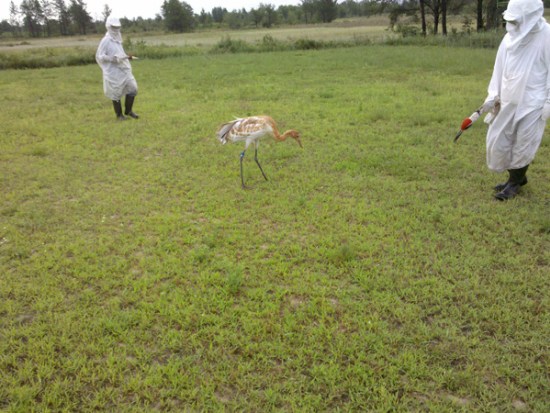
Her first day at Necedah NWR. Photo: Heather Ray
Notes from “Flight School” at Necedah NWR in Wisconsin: Arrived in Wisconsin for flight school on July 27 when she was 83 days old after traveling almost 1,000 miles by road trip from Laurel, MD. in a crate in a van. Brooke met the van in Indiana and drove #4-10 and #11-10 the rest of the way to Wisconsin. He was worried about #4-10’s history of leg problems because she had to stand up in her crate the whole trip. But when he opened the crate at her new home in Wisconsin, out she popped. She was a little unsure at first but wasn’t limping. Hooray! Soon she was airborne on a short flight to the pen door, then safely inside with her cohort mates. A fence kept her apart from the other birds until the crew could be sure they would all ‘play nice’ together.
By Aug. 9, she and the other 7 young cranes in Cohort One were flying! They were able to follow the ultralight plane in in large circles around the North Training site. She is easy to identify in the air because her injured leg hangs down, or dangles, a bit.
“She does not like to give up,” says Geoff. “And considering the road she took getting here, that’s not surprising. Even with her leg, she’d still fly after the trike to best of her ability. It doesn’t matter to her that one of her legs dangles as she flies. She really wants to do her best. She’ll occasionally drop out during training. But once she catches her breath, she’ll at least give it another go before it’s time to go back inside. Her flying’s been getting consistently better; we can always spot her flying right behind the ultralight with her dangling leg.”
October 7: The star of the flock has died. Joe Duff announced: “Tonight we lost number 4. She was found during the evening roost check with no obvious signs to tell us what happened. There was no mass of lost feathers that you might expect if aggression was the problem and certainly no predator had made it past the steel wire or the electric fencer. All we know is that one of our best birds is gone on the eve of the migration.
“When the migration starts, all of us will be thinking of #4-10 and wishing we could see her dangling leg off the wing tip one more time. Many of us will fly a fine migration in honor of her.”
NOTE: A necropsy showed that #4 had a broken neck. It may have been caused by jumping up and hitting the top net too hard.
Click here to jump to the top of this page.
Crane #5-10
Sex: Female
Hatch Date: May 8, 2010
Personality and Characteristics: A story about her parents: Chick #5-10 came from an egg laid right at Patuxent WRC. The parents were two Whooping Cranes called the “S35 pair,” a pair that has become one of my favorites. Because many of the captive birds are related, we often have to do “arranged” pairings. We let the two cranes live next door to get to know each other. Then we ‘date’ them, allowing them to share a pen, but under supervision, to make sure they get along. If they seem to like each other, they eventually progress to the point where they live together all the time, unsupervised. The process can last anywhere from a few weeks to over a year! Sometimes the birds don’t hit it off and we start over again, but in this case it worked. They formed a strong pair bond and have been producing chicks for several years. This year, S35 female laid the eggs that later hatched into #5-10, #15-10 and #16-10.
-Jane Chandler, Patuxent WRC
Chick #5-10 tends to be very stubborn and was always a little more challenging for handlers when still a wee chick. Sometimes it took handlers as much as a half hour to get #5-10 to walk onto the scale and stay there long enough to get weighed.
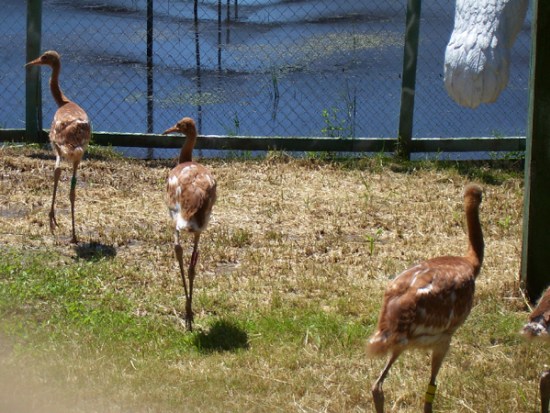
Welcome to Wisconsin! Photo: Geoff Tarbox
Notes from “Flight School” at Necedah NWR in Wisconsin: Arrived in Wisconsin for flight school with other Cohort #1 chicks on June 30 when she was 53 days old. She will live together with the other Cohort #1 chicks at the North pen until all the chicks of the Class of 2010 are later joined in one large group.
During the training session on June 8 she paid full attention to the ultralight plane “parent,” even though two adult whooping cranes joined in the group chasing down the runway with the ultralight. Another day when it was super soggy in the pens after rain storms, she paid no attention to the adults who showed up when she and other chicks napped on the grass runway because it was the least soggy place around.
“While she is a sweet bird”, says Geoff, “I don’t think she’s one of the brightest we’ve ever had. She always seemed a little slower on the uptake than birds her age, and slower to develop. She’s still one of the last birds in or out, and is one of the first birds to drop out. She still doesn’t like to leave the runway when the ultralight takes off. But she still makes progress, whenever she finally understands what we want her to do — so we hope that will happen on a day-to-day basis.”
By September she was better about following the trike. She still liked to hang back with #5-10, or drop off the flight a half mile away from the pen. If they do drop out, the good news is that they’re pretty good at catching up with the group on their own. One time #5-10 dropped off in some clearing a half mile away from the pen. Richard and Geoff thought they’d have a busy morning trying to find her again, but she came back on her own as they were putting the other birds back in the pen.
Still, #5-10 (along with #1-10 and #9-10) has a bad habit of flying a single lap and then landing on the runway. That has to change before migration!
First Migration South, Led by Ultralight Airplane: Chick #5-10 left Necedah NWR on her first migration on October 10, 2010. She was one of seven to take off with Richard’s plane. Find day-by-day news about the flock’s migration and read more about #5-10 below.
Day 1, October 10: She was one of three dropouts that landed with only 2 miles left to go to reach the first stopover. Even though she finished the trip in a crate by car, she flew a great 21 miles on her first day.
Day 62, Dec. 10: After today’s final flight with the Class of 2010 in one large group, she was put into the pen with the four other birds headed to a winter home at St. Marks NWR. Crane #5-10’s next flight (Dec. 15) will complete her first migration!
First Winter, Release Site at St. Marks NWR: The St. Marks Five had been banded and got health checks soon after arrival. The top net was removed from their pen and they were set free to come and go on Dec. 25, 2010!
Crane #5-10 worries Brooke at bedtime. She would rather stay out and forage and grub than join the other four youngsters in the large penned area. Like the others, she should fly back into the safety of the pen, walk out on the oyster bar, and roost with her flock mates as night comes. Two yearling cranes (#25-09 and #29-09) are like older siblings at the pen site. They are allowed to hang around with this year’s youngsters. They call to #5-10 from inside in frustration. Sometimes the other four chicks join in too. “COME IN HERE NOW! TIME FOR BED!” It’s always a huge relief when she finally flies into the pen to roost in safety.
Spring 2011, First Unassisted Migration: April 3 was the day! The winds switched around to the south and the warm temps meant good thermals. Brooke watched as the three remaining youngsters kept taking off on a long flight and then returning to the pen to strut on the oyster bar and forage. Before long it appeared their ‘practice runs’ were over. Calling loudly and full of purpose, females #5-10, #6-10, and #10-10 launched one last time. “Up and up and up they spiraled, effortlessly riding the wind until they went from birds, to dots, and then to mere specks against the blue sky,” wrote Liz upon hearing Brooke’s report. They’re on their way home! A PTT reading showed #5-10 in Dane County, Wisconsin on the night of April 13. Cranes #5-10 and #6-10 were both confirmed there on April 15. On April 29 they were back on Necedah NWR, first solo migration complete!
Fall 2011: Wintered in North Carolina with crane #28-08.
Spring 2012: Crane #5-10 and #28-08, who wintered in North Carolina, were located by tracker Eva in Bartholomew County, Indiana on Feb. 29. She and her mate completed migration back to Necedah NWR on March 11. The pair were seen sitting on a nest platform at Necedah NWR on April 11 but tracker Eva said: “Since #5-10 is only two years old, we probably won’t call this an official nest unless we see more evidence of consistent incubation, or eggs in the nest. On May 3, Eva said: “#28-08/#5-10 apparently have a nest in Marathon County. They were sitting during both checks on May 1 and both checks on May 2, so we are going to go ahead and assume that they have an egg.” They were still incubating as of May 29. Trackers collected their single infertile egg on June 4 after the pair incubated it past full term and it didn’t hatch.
Fall 2012: Spotted by Eva at Hiwassee SWA in Meigs County, TN with seven other Whooping cranes.
Spring 2013: Crane #5-10 and #28-08 completed spring migration by April 2. By late April or early May they were reported nesting! By late April or early May they were reported nesting. This pair was among only three crane pairs still sitting on a nest on May 7 after a three-day span when all 17 other nests were abandoned, possibly due to an outbreak of black flies. On May 21, they hatched the first wild-hatched chick (#W1-13) of this season. This female is three years old, and this is her first successful nest. On May 29, a survey flight by Eva revealed only one of the two chicks at the nest site.
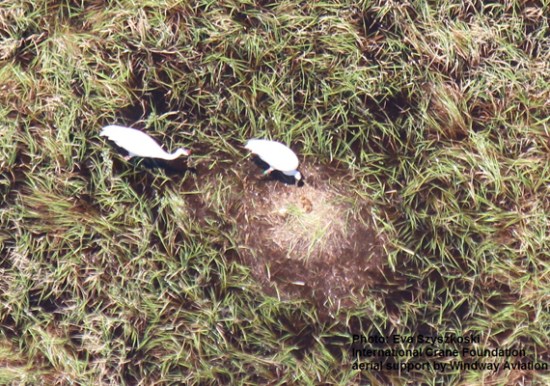
By May 23, the second chick (#W2-13) had hatched.
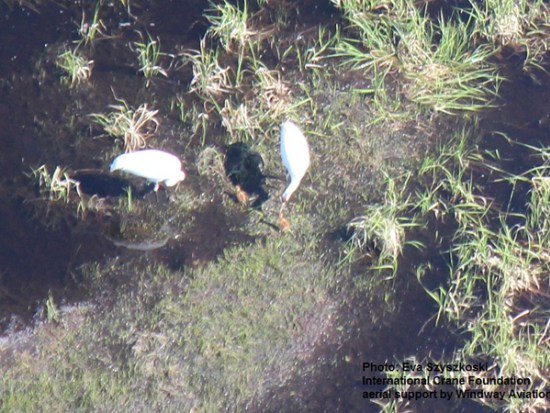
Eva saw both chicks on May 26, so it appeared that only one of the twins (#W1-13, below, May 29) still survived. It is very rare for twins to survive in the wild, especially to very new and inexperienced parents. The chick was observed with parents when it was two weeks of age, and again when it was just days shy of 1 month of age. Unfortunately, chick #W1-13 was lost between the afternoon of 26 June and the afternoon of 2 July at 36-42 days of age.
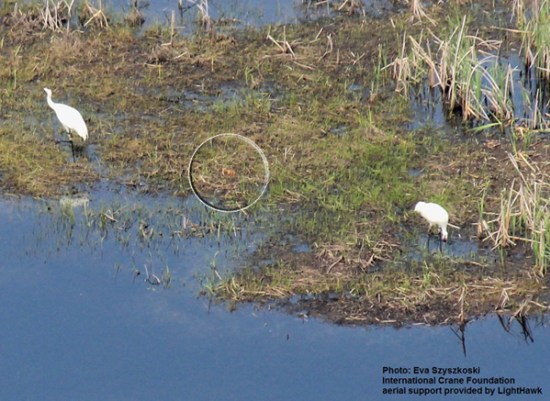
Fall 2013: Crane pair #28-08 and #5-10 wintered at the Hiwassee WR in Tennessee with many other whooping and sandhill cranes.
Spring 2014: #5-10/#28-08 and #37-07 began migration together from their wintering area at the Hiwassee WR in Tennessee on 21/22 February. They were reported in Jackson County, Indiana, on the evening of Feb. 22nd. They stayed in the area until March 21, when a signal from #5-10 was detected heading north. They were photographed on their territory in Marathon County, Wisconsin, in April. The pair (#5-10 and #28-08) built a nest and hatched a chick, which was observed with them on the May 29 aerial survey flight.
Fall 2014: Crane pair #5-10 and #28-08 returned to their usual wintering area in Meigs County, Tennessee with many other whooping and sandhill cranes.
Spring 2015: #5-10/#28-08 returned to the Necedah area and hatched twin chicks around May 16. By June 8, just one chick survived, shown below, but the chick had died by June 23.
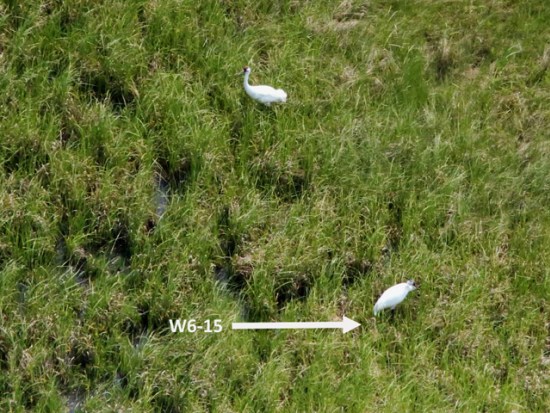
Photo: Beverly Paulan, Wisconsin DNR
Fall 2015: Crane pair #5-10 and #28-08 returned to their usual wintering area in Meigs County, Tennessee.
Spring 2016: Female #5-10 and mate #28-08 had returned to their Necedah area territory by the end of March. No chicks for them this summer.
Fall 2016: Crane pair #5-10 and #28-08 returned to their wintering area in Meigs County, Tennessee.
Spring 2017: Crane pair #5-10 and #28-08 returned to their Wisconsin territory in Marathon County and were nesting by early April. Their chick, #W4-17, was found by pilot Bev Paulan on a May 12 flight (photo below) and was still doing well at age 17 days when seen on Bev’s May 25 flight.
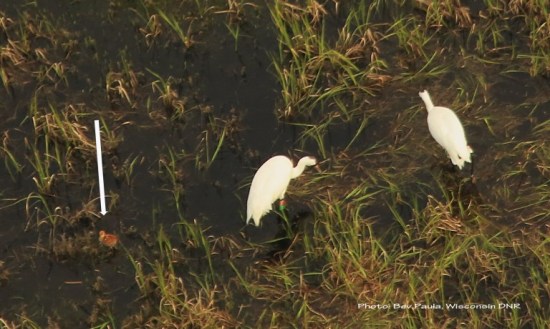
Summer 2017: Unfortunately, chick W4-17 was last seen at the end of May. The pair was seen without a chick on May 27.
Fall 2017: In November, pair 5-10 and 28-08 migrated to southern Indiana, and were back at their wintering area in Meigs County, Tennessee in the beginning of December.
Spring 2018: 5-10 and 28-08 had returned to their nesting territory in Marathon County, Wisconsin by the end of April. They began nesting in May, and their nest was set to hatch in early June, but trackers were unable to confirm if chicks had hatched. At the end of June, one parent may have been seen brooding chicks on the nest, but the pair was next seen in July without chicks.
Fall 2018: By the end of December, 5-10 and 28-08 had returned to their wintering grounds in Meigs County, Tennessee.
Spring 2019: 5-10 and mate 28-08 returned to their territory in Marathon County, Wisconsin by mid-April.
5-10 and 28-08 were first seen nesting on pilot Bev Paulan’s April 26 flight. On May 31, Bev saw two chicks- W10-19 and W11-19! Unfortunately, the parents were seen without W11-19 in mid-June, and without W10-19 at the end of June.
Fall 2019: 5-10 spent the summer in Marathon County, Wisconsin with mate 28-08. 5-10 was observed alone on her wintering grounds in Tennessee in mid-November. She spent the winter here with male 14-12. The two went their separate ways in mid-February as 5-10 started making her journey northward, making stops in Kentucky and Indiana.
Spring 2020: 5-10 was first observed in Marathon County, Wisconsin, at the beginning of June. She is currently there alone.
Fall 2020: 5-10 spent the summer alone and was first seen on her wintering grounds in Tennessee at the beginning of November. We hope she finds a mate on her way home!
Spring 2021: 5-10 still is without a mate and has been spending her time in Marathon County, Wisconsin, on her normal territory.
Fall 2021: 5-10 spent the remainder of her summer without a mate in Marathon County, Wisconsin. She was first spotted on her wintering grounds at Hiwassee Wildlife Refuge in Meigs County, Tennessee on November 26th.
Spring 2022: 5-10 returned to her territory in Marathon County, Wisconsin in late March. She is currently still enjoying the single life.
Fall 2022: 5-10 migrated back to Hiwassee Wildlife Refuge in Meigs County, Tennessee, her usual wintering area. She was seen with male 14-12 during the winter. We hope this year their bond will be stronger, and they’ll stick together! Fingers crossed. If not, at least they’ll have a buddy for the winter.
Spring 2023: In early March, 5-10 flew to southern Michigan and spent some time in Lenawee County before coming back to her territory in Marathon County, Wisconsin. She has previously been seen with 14-12, but unfortunately, he did not join her on her trip back.
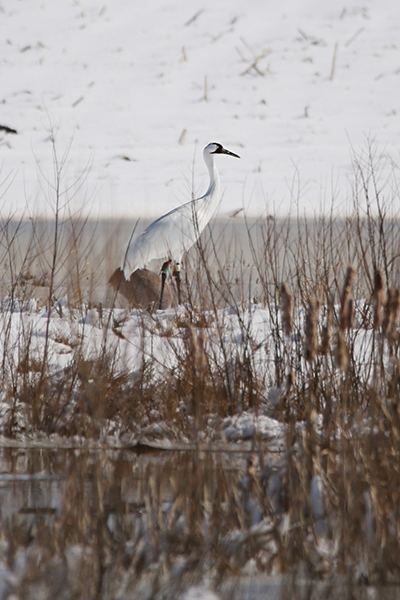
Fall 2023: 5-10 spent her summer in Marathon County, Wisconsin, where she then traveled over to Portage County and was last seen there at the end of August. We hope to see 5-10 in Wisconsin again this spring!
Click here to jump to the top of this page.
Crane #6-10
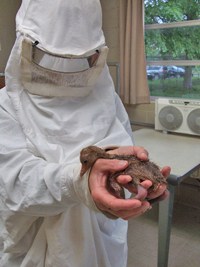
Sex: Female
Hatch Date: May 11, 2010
Personality and Characteristics: A story about her mother: Many years ago, we had a few pairs that broke their eggs if the eggs were not removed immediately. If one of those pairs was expected to lay an egg, we would post a watcher so the egg could be rescued as soon as possible. I remember huddling in the cold about 2:00 AM waiting for one of those females to lay. When she finally did, I rushed into the pen (a daunting task, facing two aggressive birds nearly as tall as oneself!) and snatched away the egg. What a thrill! Those two egg-breakers have quit their bad habit and one of them laid the egg that hatched into #6-10. -Jane Chandler, Patuxent WRC
Chick #6-10 was a loner, an introvert, and not fond of confrontations. She was content to wander off and do her own thing. This made #6-10 hard to raise as a baby chick since her attention was on everything else but the trainer. She would rather wander around the outdoor pens happily foraging while the other chicks tried to hang out with “Mommy,” the costumed handler.
Notes from “Flight School” at Necedah NWR in Wisconsin: Arrived in Wisconsin for flight school with other Cohort #1 chicks on June 30 when she was 50 days old.
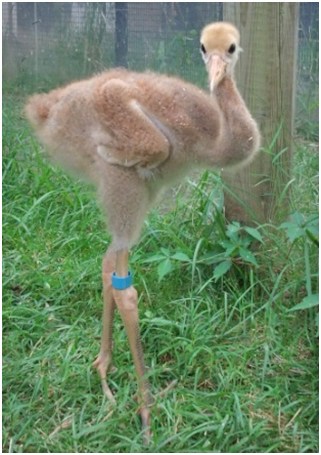
“I always thought of her as being a calm and trusting bird,” said Geoff. “She didn’t seem to worry about the stuff the other chicks did. That’s the impression I’ve had of her ever since I saw her socialized. While #8-10 and #9-10 were trying to find the costume or lay down where they thought it was hiding, little female #6-10 was busy exploring her new pen. I first thought it was independence. But after spending time with her in Necedah, I think it’s more that she has a real sense of security. Even if she can’t see the costume, she knows it’s not far away if trouble arises. Like #1-10, she seems to completely trust the costume, and is one of the first to greet it, and one of the first to come in and out the gate. She’s even one of the best fliers in the cohort since she’s willing to put her faith in the costume that’s flying the ultralight.”
She proved to be an excellent flier and follower during training!
First Migration South, Led by Ultralight Airplane: Chick #6-10 left Necedah NWR on her first migration on October 10, 2010. She was one of seven in the Class of 2010 to take off with Richard’s ultralight and one of only four to go the whole 23-mile distance on Day 1. Find day-by-day news about the flock’s migration and read more about #6-10 below.
Day 9, October 18: Crane #6-10 flew with Richard and she had his wing all to her self. “With her wings seemingly locked in place she glided along, sometimes over taking the trike. So I decided that maybe faster was better. Pulling the bar in, soon we were flying about 45 miles per hour air speed. At times we reached a ground speed of 55 miles per hour. As we approached our stop in Green County we began to descend and she stayed right there on the wingtip, gliding along, the wind slipping by her feathers. When we landed, her head feathers (more hair-like at her age) were arranged as if combed to a peak along the center line of her head, pushed there by the wind.”
Day 10, October 19: “All jazzed up from yesterday’s flight, #6-10 began to experiment with the wing. She would get in front of the wing and glide on the air pushed in front, which would then push her up then down to the side and back again. This comical maneuvering would continue until she lost total control and fell down below the trike. She would then go back and retake her lead position. At first I thought she had learned her lesson, but soon she would do it again— porpoising around, with her neck and wings dodging about at weird angles. It soon became evident that she was having fun with her new found confidence in the wing. This crazy wonderful behavior continued for the remainder of the flight!”
Day 22, Oct. 31: Crane #6-10 dropped down just short of the goal, but pilot Richard swooped in to let her fly near his wing. She made it!
Day 27, Nov. 6: Little #6-10 has turned into an aerobatics queen. Pilot Richard said this bird could be in the Oshkosh air show next year. “She would fly off the slipstream in front of the wing, sometimes seemingly almost inverted, her flight twisting about, her neck more serpent-like than bird-like. And even though her head seemed to be straight and level the whole time, her body and wings danced around like a Pitt’s Special at an air show.” Richard was surprised when all the other birds landed at the new stopover by Joe’s plane while #6-10 kept flying with Richard’s as though glued to his wing! Finally the two of them landed, too. Good job, both of you!
Day 48, Nov. 26: On today’s double-leg, #6-10 did not want to land after flying 116 miles. When lead pilot Joe’s throttle got stuck, Richard moved in to lead the birds to landing. All but #6-10 landed as Richard pulled up and away, but #6-10 was determined to follow his aircraft. Richard made three additional attempts to drop off #6-10, but she still wouldn’t land. By this time, Joe’s throttle had freed itself so Joe picked up #6-10 again. Joe set up to land, and loyal #6-10 followed him, just inches from Joe’s wingtip. Hooray, #6-10!
Day 62, Dec. 10: After today’s final flight with the Class of 2010 in one large group, she was put into the pen with the four other birds headed to a winter home at St. Marks NWR. Crane #6-10’s next flight (Dec. 15) will complete her first migration.
First Winter, Release Site at St. Marks NWR: The St. Marks Five had been banded and got health checks soon after arrival. The top net was removed from their pen and they were set free to come and go on Dec. 25, 2010!
Spring 2011, First Unassisted Migration: April 3 was the day! The winds switched around to the south and the warm temps meant good thermals. Brooke watched as the three remaining youngsters kept taking off on a long flight and then returning to the pen to strut on the oyster bar and forage. Before long it appeared their ‘practice runs’ were over. Calling loudly and full of purpose, females #5-10, #6-10, and #10-10 launched one last time. “Up and up and up they spiraled, effortlessly riding the wind until they went from birds, to dots, and then to mere specks against the blue sky,” wrote Liz upon hearing Brooke’s report. They’re on their way home!
Female #6-10 migrated most of the way with #5-10 and #10-10. After leaving St. Marks on April 3, their migration stops were St. Clair County, AL, Allen County, KY, Howard County, IL, Newton County, IN, McHenry County, IL, and Dane County, WI. Tracking crew chief Eva reported that a PTT reading showed #5-10 in Dane County, Wisconsin on the night of April 13 and cranes #5-10 and #6-10 were both confirmed there on April 15 but #10-10 was not with them. Did she zoom ahead to the finish line at Necedah NWR? Stay tuned. Cranes #5-10 and #6-10 were confirmed on Necedah NWR April 29, migration complete!
Fall 2011: Crane #6-10 migrated to Greene County, Indiana for the winter.
Spring 2012: Returned to the Mead SWA, Marathon Co, Wisconsin. However, on June 13 her carcass was discovered during an aerial survey over Necedah National Wildlife Refuge. Her remains have been sent to the USGS National Wildlife Health Service in Madison for necropsy.
Click here to jump to the top of this page.
Crane #8-10
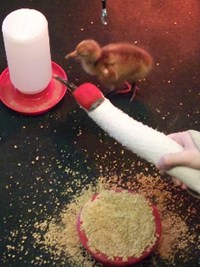
Sex: Male
Hatch Date: May 13, 2010
Personality and Characteristics: Chick #8-10 seemed to be the boss in the little group of #6-10 and #9-10. He was not afraid to act tough even with the bigger birds if he thought he could get away with it.
Before he was born: During a severe storm at Patuxent WRC in May, a limb blew off a tree and landed on the nest a Sandhill Crane that was incubating two Whooping crane eggs. One of those eggs contained the chick that would become #8-10. The crane had jumped away as the branch fell, but she knocked one of the eggs out of her nest. The egg rolled away from the nest and wasn’t found by a worker until the next morning. the egg was cold and the sandhill crane pair was in great distress over it. It was a miracle that the egg survived and hatched! Now it’s chick #8-10. -Jane Chandler, Patuxent WRC
Notes from “Flight School” at Necedah NWR in Wisconsin: Arrived in Wisconsin for flight school with other Cohort #1 chicks on June 30 when he was 48 days old. These chicks will live together at the North pen until all the chicks are later joined in one large group.
He didn’t mind at all when two adult Whooping cranes joined in the training session on July 8, running along with the trike and chicks and trying to keep up with them.
“I think he borrows a bit from his big and little sisters,” said Geoff. “Like #6-10, he’s very trusting of the costume and is one of the three greeters of Cohort 1. He comes in and out of the pen eagerly. He is perfectly happy to follow the ultralight, since the costumes have never led him astray and he trusts them. But I must add that he sort of needs assurance from the costume before he tries anything new. He will get slightly anxious every now and then if left alone in a strange place with strange birds (but not as anxious as #9-10). When I was socializing him, he’d almost always lay down next to the shed after he saw the costume go inside it. But as long as he knows something’s safe (whether from watching the costume or from experience), and the costume is near, he’ll get over any doubts and do whatever we’re training him to do — again and again, without a second thought.”
“Crane #8, along with #1-10, #2-10, and #3-10, has always been high on the pecking order. He’s a good flier and follower, too. He’s a very dependable bird.”
First Migration South, Led by Ultralight Airplane: Chick #8-10 left Necedah NWR on his first migration on October 10, 2010. Always dependable, he was one of seven in the Class of 2010 to take off with Richard’s ultralight and one of only four to go the whole 23-mile distance on Day 1. If you don’t see more about #8-10 below, it means he flew every day without mishap or mischief!
Day 62, Dec. 10: After today’s final flight with the Class of 2010 in one large group, he was put into the pen with the four other birds headed to a winter home at St. Marks NWR. Crane #8-10’s next flight (Dec. 15) will complete his first migration!
First Winter, Release Site at St. Marks NWR: The St. Marks Five had been banded and got health checks soon after arrival. The top net was removed from their pen and they were set free to come and go on Dec. 25, 2010!
Spring 2011, First Unassisted Migration: On March 21, males #8-10 and #1-10 departed on migration along with the two older birds (#25-09 and #29-09) that had been staying at the pen site for much of the winter. Only #29-09 remained with them throughout migration. Data from their GPS transmitters indicated that they made it to Macon County, Alabama, nearly 200 miles to the north and right on course. GPS data from #1-10 indicates that on the night of March 24th, he had made it to Jackson County, AL and then next in Barren County, Kentucky; Cook County, IL; and Juneau County, WI. Cranes #1-10, #8-10 and #29-09 completed their journey north by the night of April 7. The three birds then moved to Wood County, WI. Crane #8-10 and #1-10 wandered after they returned. They were near Zumbrota (Goodhue County, Minnesota) through at least May 17. PTT readings indicated a roost location on the southern pools of Necedah NWR on the night of May 19. By the night of May 21 they had returned to Minnesota, this time west of Dennison (Rice County). Cranes #8-10 and #10-10 remained there several weeks but were back on Necedah NWR by June 26.
Fall 2011: Crane #8-10 was last detected with #6-10, #19-10 (DAR) and #25-10 (DAR) in Adams County, Wisconsin, on November 13. He was found with them on migration. He wintered in Madison County, Florida.
Spring 2012: Crane #8-10 landed in the Whooping Crane Exhibit at the International Crane Foundation (Baraboo, Wisconsin) on April 1st and hung out with the captive cranes named Omega and Seurat. ICF workers chased #8-10 away! In late April he joined widowed female #37-09 (DAR) on the old territory she had shared with her previous mate on Necedah NWR.
Fall 2012: He migrated south with female #37-09 (DAR) in November and wintered in Greene County, Indiana.
Spring 2013: Male #8-10 was confirmed back on Necedah March 31 but likely arrived on or by March 30, with his mate, female #37-09 (DAR), who was found dead on their summer territory in Juneau County, Wisconsin; her remains were collected on May 12, 2013. He spent the summer with two of only six wild-hatched chicks in the project’s long history that managed to survive the black flies, predators, hunters, inexperienced parents and other dangers, only to die during the autumn. Then he took up with female #23-10, but was not with her when he showed up for winter in Florida (below).
Fall 2013: Male #8-10 migrated to Florida, where he was very likely the single bird reported in Jefferson County, Florida on January 26. He then continued south and unexpectedly showed up at the St. Marks pen site on January 30. “This male was one of only 7 ultralight birds to come to Florida this winter in a WCEP population that lost 16 cranes in the last few months,” noted Brooke upon seeing this young crane once again. The bird tried to land with the chicks again in March, but was driven off from the pen area by #4-12. “Time and time again he had attempted to cross the mote, scale the pen walls and join the kingdom of the chicks, only to be thwarted again and again by the aggressive rage of that ruling despot,” wrote Brooke.
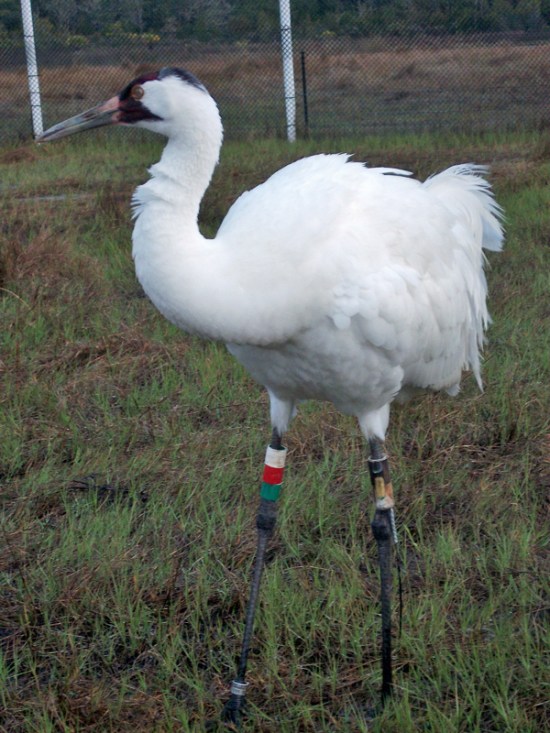
Photo: Brooke Pennypacker
Spring 2014: Crane #8-10 must have given up on Florida, because ICF tracker Eva Syszkoski confirmed him in Indiana on March 12. His spring migration is underway and on April 4 he was confirmed back on territory near the Necedah NWR, reunited with female #23-10 (DAR).
Fall 2014: Crane #8-10 began migration Nov. 1 from Necedah and wintered in Greene County, Indiana with pair #23-10 DAR and #6-09.
Spring 2015: Returned to Necedah NWR/Juneau County, Wisconsin.
Fall 2015: Migrated from Necedah NWR/Juneau County to winter territory in Greene County, Indiana.
Spring 2016: Male #8-10 was observed with female #32-09 (DAR) back on territory at Necedah NWR on March 30 by Wisconsin DNR pilot Bev Paulan.
Fall 2016: Last observation of male #8-10 was in Wood County, WI by Bev Paulan. This crane did not turn up at Goose Pond in Greene County, Indiana this fall/winter.
Click here to jump to the top of this page.
Crane #9-10
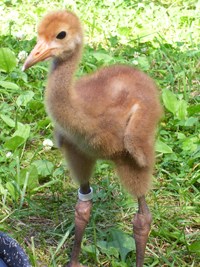
Sex: Female
Hatch Date: May 16, 2010
Personality and Characteristics: Chick #9-10 was clingy and dependent. In the outdoor pens she went out of her way to hang out with the costumes (“Mommy”). In fact #9-10 would rather sit and bake in the sun with the costume than go into the shade alone to get a drink! “When we were trying to socialize her, she’d always try to hang out or pace where the costume was hiding, and was one of the first to run up to the costume if it came out,” said Geoff. “I think she might’ve been uneasy in her new surroundings.” It helped when #9-10 began living with the other chicks in the outdoor pens without much contact from the costumes, but she was, and remained, always the first chick to greet the costumes when they appeared.
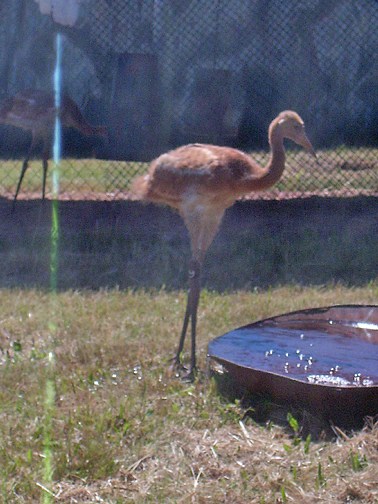
Welcome to Wisconsin! Photo: Geoff Tarbox
Notes from “Flight School” at Necedah NWR in Wisconsin: Arrived in Wisconsin for flight school with other Cohort #1 chicks on June 30 when she was 45 days old.
On July 8 Chick #9-10 was eagerly running off down the runway with the other chicks behind the ultralight plane when two adult whoopers joined in. They ran along with the trike and chicks and tried to keep up. Chick #9-10 didn’t pay any attention to them. For most of the rest of July she was a lollygagger. But if she got a few days off between sessions, she was raring to go again.
Geoff feels that #9-10 is the anxious chick in the flock. “Like #5-10, she’s not as bright, and seems to be startled by anything new. Here at Necedah, we sometimes had trouble getting her out of the gate. Sometimes, she was so scared of the gate that she wouldn’t leave the pen. She’s gotten better, but she still approaches the gate a little slowly and tentatively. I think she was bumped and shoved around by some other birds as they came out one too many times. But despite her anxiety, she seems less interested in the costume now than she was at Patuxent.”
By September 1 she was not hanging out on the runway anymore but she WAS flying with all the other “big kids.” She was now just as eager to come out as all the other crane-kids. But as the weeks went on, she got into the habit, along with #1 and #5, of flying a single lap then landing on the runway. That will need to change before migration begins.
First Migration South, Led by Ultralight Airplane: Chick #9-10 left Necedah NWR on her first migration on October 10, 2010 but turned back shortly after take off. She did not fly any of the 23-mile distance on Day 1, but made the trip in a crate by road. Find day-by-day news about the flock’s migration and read more about #9-10 below.
All Days: Magnificent #9 performed like a champ!
Day 63, Dec. 11: Yesterday was the last time all ten birds will fly together as a group. Today #9-10 and the other four birds that will winter at Chassahowitzka NWR flew 86 miles closer to their final destination! They’re now in Gilchrist County, with only two more flights to go! [They would have to wait for their next flight until January 14, 2011 due to reason’s beyond the team’s control.]
Day 72, Jan. 14: Finally in the air again! After so many days in the pen, the Chass Five gave pilots Joe and Richard a rodeo before they got on course to Marion County and the flyover arrival celebration. One more flight gets them to their winter home!
Day 73, Jan. 15: First migration complete!
Winter at the Chass Release Pen: Eva says that female #9-10 is the indifferent one in the group of five. She does not really care about what else is going on when the costume is in the pen and often gets distracted by something interesting in the water or elsewhere. She was the only one to still have her chick voice in mid-February when the others were changing into adult voices.
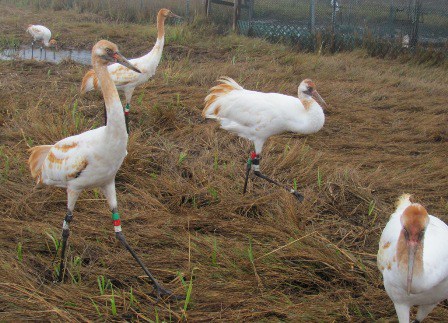
The Chass Five, free in January in Florida. Photo: Eva Szyszkoski
Spring 2011, First Unassisted Migration: She began migration on April 4 from the Florida pen site with flock mates #3 and #17! Her PTT that night fired off from Terrell Co, GA, which is about 240 miles from Chass. The second stop (night of 5 April) was on the Elmore/Tallapoosa County border in Alabama, about 100 miles NW of the first stop. Stop 3 was Clark County, IN. Next stop was Livingston County, IL and then Lee County IL. After further stops in Clark County, IN, Livingston County, IL and Lee County, IL, Cranes #3, #9 and #17 were confirmed —still together —at their 6th migration stop (Sauk County, Wisconsin) on April 15. They moved a little south again before officially completing migration.
Fall 2011: Cranes #9-10 and #17-10 wintered in Levy and Marion County, Florida.
Spring 2012: Crane #9-10 returned to Wisconsin and summered with male #19-11 in Adams/Portage County.
Fall/Winter 2012-13: Crane #9-10 and #19-11 migrated to Union County, Illinois by Dec 18th and remained for the winter.
Spring 2013: On April 11, cranes #9-10 and #19-11 were confirmed back in Adams County, Wisconsin! (They would not have been flying the last few days due to unfavorable weather conditions, so they likely have been around since at least April 8, noted tracker Eva Szyszkoski.
The carcass of female #9-10 was collected on her summering territory in Adams County, Wisconsin, on April 25. Death likely occurred around April 19, noted tracker Eva Szyszkoski. The bird’s remains were sent to the USGS National Wildlife Health Center in Madison for necropsy.
Click here to jump to the top of this page.
Crane #10-10
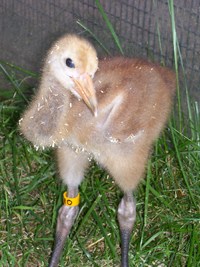
Sex: Female
Hatch Date: May 16, 2010
Personality and Characteristics: Before she hatched whooping crane chick #10-10 had already traveled many miles before hatching. A man named Dwight Knapik is the flock manager for the captive Whooping cranes at Calgary Zoo in Canada. He and other crane experts get the eggs of those cranes delivered to important Whooping crane projects. In spring 2010 Dwight carefully packed some fresh crane eggs in a portable incubator long before you were even awake. Then he spent hours getting them warmly and safely through airport security, customs officials, and traffic. He brought the eggs all the way from Calgary, Canada to Maryland, USA. The eggs were tucked into the incubator at Patuxent WRC. Those eggs hatched into chicks #2-10 and #4-10. They were later joined by #10-10 and #12-10, also from Calgary. –Jane Chandler, Patuxent WRC
A Nickname! The team calls her Zoey “Flower Child” Woodstock. Why?
• “Flower Child” is from Trish, who says says #10-10 has been crazy about flowers—especially purple clover—ever since first seeing them. She gobbled them down whole. When she was tiny you could sometimes see the bulge travel down her neck as she swallowed!
•”Woodstock” is from Brooke, who says because #10-10 is always so spacey and running around after flowers. “Before I would bring her out to train, I’d walk around and pick all the flowers so I could get her to follow.”
• Zoey is from Geoff, who likes a character named Zoey in one of his video games. “She always seems to be on her own little planet,” said Geoff. She loved to snap at clovers and dandelions at Patuxent WRC where she was hatched.
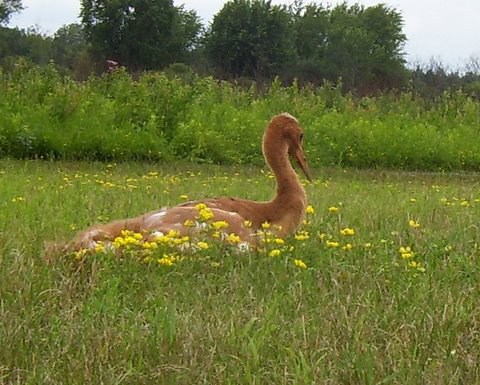
And that’s the story of how she got her full name: Zoey “Flower Child” Woodstock. Photo: Operation Migration
Notes from “Flight School” at Necedah NWR in Wisconsin: Chick #10-10 left the “hatchery” and “Ground School” in Maryland and arrived by airplane at Necedah NWR in Wisconsin on July 9 with other cohort 2 chicks. (What was her age on that day?) This group will live at “Canfield site” until the two cohorts join together when they are a bit older. She had a clean bill of health and was ready for the next big step in her life. At the pen, she took off in her own direction to explore and gobble up bugs, tiny frogs, and even small rocks. From the blind (hiding spot), Geoff even saw her and #15-10 playing in one of the water pans. “From the way they were dipping their feet and sipping up the water, I think it’s the start of a beautiful friendship,” said Geoff. He felt that #10-10 had been lonely since her first and best buddies at Ground School at Maryland’s Patuxent WRC were not with her anymore. (Chick #11-10 was held back in Maryland to get better after being sick, and #14-10 died after his leg was broken.)
After she could fly, she liked to land in the marsh instead of on the grass. She knows where cranes belong!
“It’s not uncommon to see her wander off from the rest of the group,” Geoff reminds us. “Even when the dry pen was flooded, and we let the birds out on the runway to rest on dry ground, she’d spend most of her time wandering through the marsh. But she does like flying; she often comes out before everyone else. However, I think she still misses #12-10 and #14-10, since they were her old socializing buddies from Patuxent. When she arrived at Necedah, she didn’t seem very interested in what #15-10 and #17-10 were doing.” Everyone was glad when she seemed to feel better after her buddy #11-10 arrived in Wisconsin.
On September 14 when the costumed handlers were releasing the older birds in Cohort One to fly with the ultralight plane, #10-10 and #17-10 watched from inside the pen, eager for their turn. Somehow they managed to slip past the fence and the handlers — and took off flying with the older birds! AND they flew the entire 25 minutes of the training flight!
October 8: Either on take-off, or landing today, #10-10 hurt her leg. Joe drove her to the International Crane Foundation where Dr. Barry Hartup suited up and examined her leg. She’s just fine, but does have a bad abrasion. She was very calm and already starting to put weight on the foot. This take-off was meant to be the migration departure, but when they met with headwinds aloft, the pilots decided it would be too tough to lead the young birds the whole 23 miles to stopover #1. It became a training flight instead.
First Migration South, Led by Ultralight Airplane: Chick #10-10 left Necedah NWR on her first migration on October 10, 2010. Find day-by-day news about the flock’s migration and read more about #10-10 below.
October 10, 2010: What a champ! Brave #10-10, who badly bruised her leg two days ago, was a trooper today. She and 3 others didn’t want to take off with Richard on Migration day 1. But the Swamp Monster was called into action, and #10-10 DID follow Brooke as he began leading her south to the first stop, 23 miles away. But she was having difficulties getting any altitude, and eventually she landed in a marsh. Brooke noted the coordinates and passed them along to Trish so that the ground crew could retrieve #10-10 and transport her the remaining 12 miles by crate. “Zoey” was happy to see her rescuers, who tramped down the tough grass (like a real mama crane would do) so she had a better path to walk to her crate. Soon she joined her flockmates again, Day 1 complete.
Day 8 (October 17): #10-10 dropped out shortly into today’s flight. She was found in the woods near the pen. She must have dropped out unnoticed and made her way back. She likely saw the dismantling of the pen and decided to hide. She and #2-10 were the two birds crated today and moved to the new site by road.
Days 9 and 10 (October 18, 19): Walt said: “Usually the birds don’t like being boxed and stay with the flock on the next flight. I am happy to say that was the case on these next two legs of the journey for #10-10, and she has her place back in line as we head on south.”
Day 62, Dec. 10: After today’s final flight with the Class of 2010 in one large group, she was put into the pen with the four other birds headed to a winter home at St. Marks NWR. Crane #10-10’s next flight will complete her first migration!
Day 67, Dec. 15: Migration Complete!
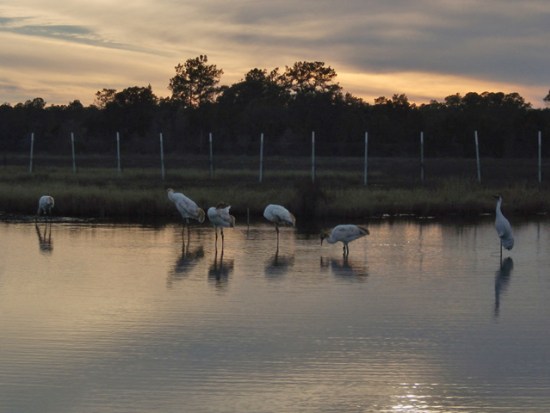
Roosting in the open-topped enclosure at St. Marks NWR Photo: Operation Migration
First Winter, Release Site at St. Marks NWR: The St. Marks Five had been banded and got health checks soon after arrival. The top net was removed from their pen and they were set free to come and go on Dec. 25, 2010!
One evening, a flock of juvenile ibis flew in and landed on the pond’s oyster-shell bar with the cranes. Young female #10-10 tried to entice the other species to join her in dancing. “As much as she would leap and pirouette, they would just walk away. Poor little chick did look frustrated,” said Bev, who was visiting Brooke and helping with the cranes.
Spring 2011, First Unassisted Migration: April 3 was the day! The winds switched around to the south and the warm temps meant good thermals. Brooke watched as the three remaining youngsters kept taking off on a long flight and then returning to the pen to strut on the oyster bar and forage. Before long it appeared their ‘practice runs’
were over. Calling loudly and full of purpose, females #5-10, #6-10, and #10-10 launched one last time — on their way home! Crane #10-10 made it back to Wisconsin and was seen there the end of May, but then she seemed to vanish. Trackers were happy to report that she was located during an aerial survey in Dodge County, WI on July 7 and was also reported in this area the following day.
Fall 2011: She successfully migrated and was reported in Lake County, Florida with the very young female #2-11, who escaped” her ultralight-led cohort early in her first southward migration.
Spring 2012: Female #10-10 remained with young #2-11 and Sandhill cranes in Lake County, Florida, until beginning spring migration on February 13. She was reported back in Dodge County, Wisconsin, on March 18.
Fall 2012: Female #10-10 spent from July through late September in southern Dodge County, Wisconsin before fall migration. Tracker Eva Syszkoski reports that her wintering location was unknown.
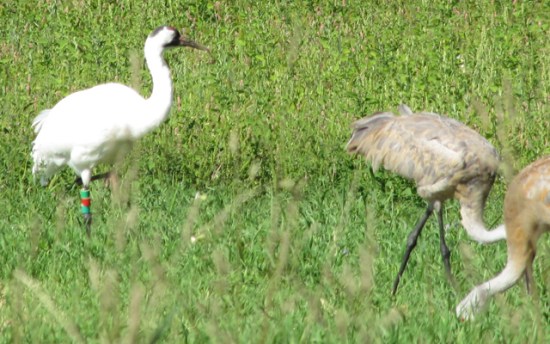
Photo: Lee Buescher
Spring 2013: Female #10-10 completed migration to Dodge County, Wisconsin on April 3, 2013.
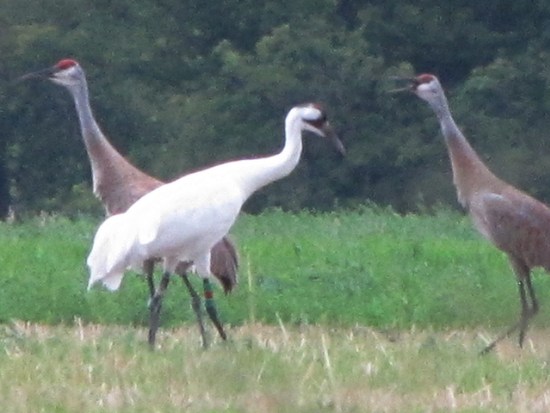
Photo: Lee Buescher
Fall 2013: Female #10-10 was photographed (below) Nov. 16 in Wisconsin. Observer/photographer Bill Gausmann reports that was her last day in the area. On Nov. 17 she took advantage of the north wind and headed south. She was seen in Jasper County, Indiana, November 21.
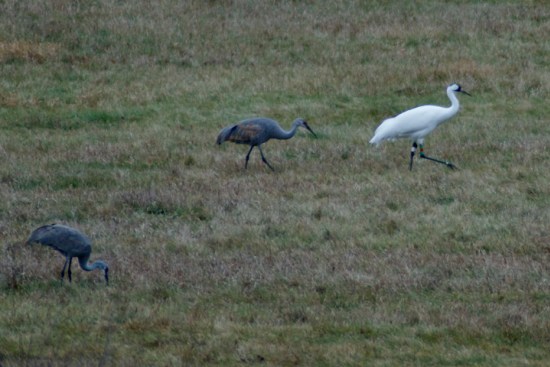
Photo: Bill Gausman
Crane #10-10 returned to Hiwassee WR in Tennessee again. The following photo of her was taken by Doug McCoy during his visit to Hiwassee on January 25, 2014:
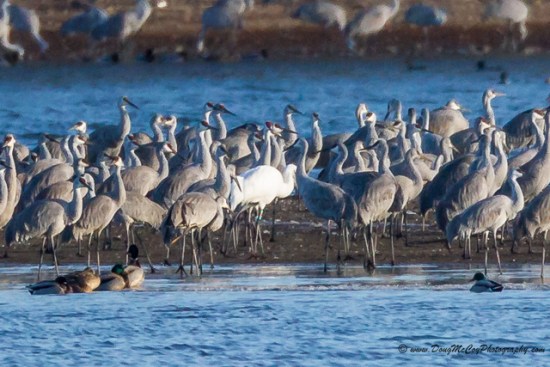
Whooping crane #10-10 looks like she is glowing among the grey Sandhill cranes.
Spring 2014: Crane #10-10 began migration from the Hiwassee Wildlife Area in Tennessee between February 16 and 21. She was next reported in Jackson County, Indiana, on February 22, where she began associating with male #41-09. They continued migration on March 21 and female #10-10 was found on Necedah NWR March 28 with a bird that had a non-functional transmitter (probably #41-09 DAR).
Fall 2014: Crane #10-10 began migration Oct. 25 from Wood County, WI. with #41-09 DAR, but their wintering location was unknown.
Spring 2015: Crane #10-10 returned to Necedah NWR and nested with male #41-09 DAR by early May but no news came to indicate nesting success.
Fall 2015: Crane #10-10 was spotted by volunteer tracker Dan Kaiser in Jackson County, Indiana on December 2nd. She was with #41-09.
Spring 2016: Crane #10-10 returned to Necedah NWR with male #41-09 DAR and the pair nested but there were no chicks for them this summer.
Fall 2016: Crane #10-10 and her mate #41-09 DAR were still in Juneau County, WI as of Nov. 13. In December they migrated to Jackson Co, IN
Spring 2017: Pair #10-10 and #41-09 DAR returned to Necedah NWR and the pair were seen nesting by early April. Their eggs were collected under the forced re-nesting study being conducted at Necedah NWR. This pair did not build another nest or produce eggs. Bev Paulan noted on her July 14th aerial survey that her mate #41-09 was seen alone and she could not locate the female #10-10.
10-10 was last seen in June 2017.
Click here to jump to the top of this page.
Crane #15-10
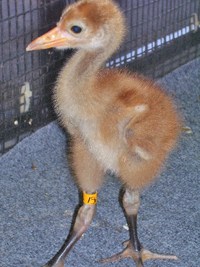
Sex: Male
Hatch Date: May 24, 2010
Personality and Characteristics: A story about his parents: Chick #15-10 came from an egg laid right at Patuxent WRC. The parents were two Whooping Cranes called the “S35 pair,” a pair that has become one of my favorites. Because many of the captive birds are related, we often have to do “arranged” pairings. We let the two cranes live next door to get to know each other. Then we ‘date’ them, allowing them to share a pen, but under supervision, to make sure they get along. If they seem to like each other, they eventually progress to the point where they live together all the time, unsupervised. The process can last anywhere from a few weeks to over a year! Sometimes the birds don’t hit it off and we start over again, but in this case it worked. They formed a strong pair bond and have been producing chicks for several years. This year, S35 female laid the eggs that later hatched into #5-10, #15-10 and #16-10. – Jane Chandler, Patuxent WRC
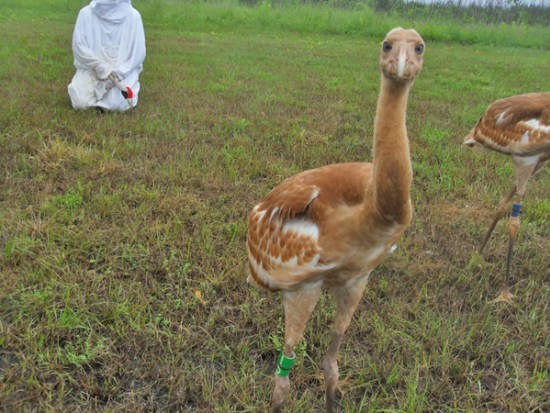
Photo: Operation Migration
Notes from “Flight School” at Necedah NWR in Wisconsin: Chick #15-10 left his birthplace and “Ground School” in Maryland and arrived by airplane at Necedah NWR in Wisconsin on July 9 with other cohort 2 chicks. (What was his age on that day?)
Dr. Barry Hartup gave him a clean bill of health and #15-10 eagerly took off by himself to explore his new home at Canfield pen. Hiding in the observation blind, Geoff saw him playing in one of the water pans with #10-10. “From the way they were dipping their feet and sipping up the water, I think it’s the start of a beautiful friendship,” said Geoff. It looks like #10-15 is right at home and ready for Flight School!
Even back in Patuxent WRC as a tiny chick, he loved being outdoors and ran around flapping his little bitty wings. In Wisconsin he’s usually one of the first ones out the gate for training.
The optimist: that’s what Geoff calls #15-10. Even when he had a droopy wing that needed a sling and a slight limp, his spirits never faltered. He was never far behind the ultralight, always following up on #10-10’s (Zoey’s) heels. “He’s gotten a little more assertive lately, but he hasn’t gotten nasty. I call him Louis. He gets along pretty well with #17-10.”
Brooke calls #15-10 “Champ” because he’s a champion at reporting for duty and trying his best every single time. He’s always willing to do whatever is happening. He IS a champ!
As migration departure gets closer, Geoff said, “#15-10 is a runt and he knows it. As far as he’s concerned, crane #2-10, and even the younger #17-10, can be top dogs, so long as he gets do his own thing.”
First Migration South, Led by Ultralight Airplane: Chick #15-10 left Necedah NWR on his first migration on October 10, 2010. He was one of seven in the Class of 2010 to take off with Richard’s ultralight and head for to the migration’s first stopover site, even though he didn’t go the distance. Find day-by-day news about the flock’s migration and read more about #15-10 below.
October 10: A few miles into the Day 1 flight, #15-10 broke away from Richard’s aircraft and Joe swooped in so the tired bird could fly with him. The Trike Cam let viewers watch #15-10 struggle to stay in the “sweet spot” behind Joe’s wing, where he would get the benefit of the air currents rolling off the wingtip. Time and again, he would drop down low and have to flap fly, so eventually Joe landed with him in a recently harvested soybean field to let him rest. Soon they were airborne again but #15-10 wouldn’t climb or cruise much above tree-top level. That’s when they came upon Richard’s trike on a field below, so Joe decided to again land with #15-10. Brave #15-10 gave it a good try and finished the last two miles of the trip in a crate by road.
Day 63, Dec. 11: Yesterday was the last time all ten birds will fly together as a group. Today #15-10 and the other four birds that will winter at Chassahowitzka NWR flew 86 miles closer to their final destination! Only 86 miles to go!
Day 72, Jan. 14: Crane #15-10 did NOT want to come out of the pen today! Finally he did and pilots Joe and Richard had a rodeo with the Chass Five before they got on course to Marion County. One more flight to go!
Day 73, Jan. 15: First migration complete!

The Chass Five, free in January in Florida. Photo: Eva Szyszkoski
Winter at the Chass Release Pen: Eva calls #15-10 the curious one. “He has to investigate anything new, especially involving the costume. This makes us have to be extra sneaky when we do things that require un-crane-like behavior, such as adding food to the feeders and scrubbing out the guzzler.”
Spring 2011: He remained at the Chass pen site with #16-10 several days after their three flockmates left on April 4. The last two in the Class of 2010 to migrate finally left on Sunday, April 17. They roosted that night in Thomas County, Georgia. With favorable winds, they resumed migration the next day, April 18, at 9:15 a.m. and landed around 5:15 p.m. in Cherokee County, AL. They eluded tracker Eva the next morning (see Eva’s report about that) and were not detected again until May 8, when Eva detected them in flight near Necedah NWR at 11:42 a.m. At 5:00 p.m. Eva saw them circling over a lake and they landed soon after.
The remains of male #15-10 were found in Juneau County, Wisconsin on August 18. He had last been recorded alive as he flew over the northern half of the Necedah NWR on July 6 with female #16-10. Information provided by the landowner indicates that #15-10 died approximately August 8.
Click here to jump to the top of this page.
Crane #16-10
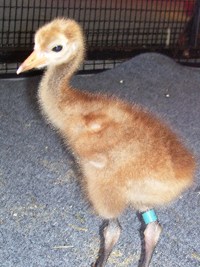
Sex: Female
Hatch Date: May 26, 2010
Personality and Characteristics: A story about her parents: Chick #16-10 came from an egg laid right at Patuxent WRC. The parents were two Whooping Cranes called the “S35 pair,” a pair that has become one of my favorites. Because many of the captive birds are related, we often have to do “arranged” pairings. We let the two cranes live next door to get to know each other. Then we ‘date’ them, allowing them to share a pen, but under supervision, to make sure they get along. If they seem to like each other, they eventually progress to the point where they live together all the time, unsupervised. The process can last anywhere from a few weeks to over a year! Sometimes the birds don’t hit it off and we start over again, but in this case it worked. They formed a strong pair bond and have been producing chicks for several years. This year, S35 female laid the eggs that later hatched into #5-10, #15-10 and #16-10. – Jane Chandler, Patuxent WRC

Here’s 16-10 and several flockmates taking part in taxi-training with the aircraft on July8 – the day before their big trip to Wisconsin! Photo: Brooke Pennypacker
Notes from “Flight School” at Necedah NWR in Wisconsin: Chick #16-10 left the “hatchery” and “Ground School” in Maryland for an airplane trip to Necedah NWR in Wisconsin on July 9 with other cohort 2 chicks. (What was her age on that day?)
She passed her arrival health check with Dr. Barry Hartup and was soon happily at home in Canfield pen with the other new arrivals. She was eager to explore and munch on bugs and little frogs. As the day went on, she found some cooler shade with the chicks to escape the hot Wisconsin sun.
Geoff called her sort of a thug. “She wasn’t above going after #11-10 (Louis) and #17-10 when she was left alone with them.” Geoff was glad she grew out of that before leaving Patuxent. “I don’t think she’s particularly smart either,” said Geoff. “I remember her needing more guidance than other chicks while getting walked as a tiny chick. But she made progress faster than #5-10 or #9-10 did when they were her age. But because of that, she sort of goes along with the group. I’ve never really seen her wander off anywhere on her own. Wherever #11-10 or #17-10 are, she’s usually not far behind them. She also seems to have lost much of her fighting spirit, as #11-10 (Louis) is able to put her in her place. I call her Frances.”
On September 11 she didn’t come back from the training flight with the rest of her cohort 2 group. She dropped out in the marsh. After Richard landed with the other four birds, Brooke lured her out of the marsh and Charlie walked her back to the wet pen.
All this time Geoff thought #16-10 had changed from a feisty chick into a bird who went along with the group. She wasn’t even one of the more dominant birds of the cohort any more. They got a BIG surprise when they mixed the two cohorts in late September! “Those first couple of times the two cohorts mingled on the runway she tried to shake down every bird in cohort one! She even had big birds like #3-10 and #1-10 on the run. Seeing the feisty dame jab, pursue, or even stomp some of these other chicks sent shivers down Geoff’s spine.
First Migration South, Led by Ultralight Airplane: Chick #16-10 left Necedah NWR on her first migration on October 10, 2010. She was one of seven to take off with Richard’s plane. Find day-by-day news about the flock’s migration and read more about #16-10 below.
Day 1, October 10: She was one of three dropouts that landed with only 2 miles left to go to reach the first stopover. Even though she finished the trip in a crate by car, she flew a great 21 miles on her first day.
Day 63, Dec. 11: Yesterday was the last time all ten birds will fly together as a group. Today #16-10 and the other four birds that will winter at Chassahowitzka NWR flew 86 miles closer to their final destination! They’re now in Gilchrist County, FL, with only 86 miles and two flights to go! (But they would have to wait for their next flight until January 14, 2011 due to reason’s beyond the team’s control.)
Day 72, Jan. 14: Finally in the air again! After so many days in the pen, the Chass Five gave pilots Joe and Richard a rodeo before they got on course to Marion County and the flyover arrival celebration. One more flight gets them to their winter home!
Day 73, Jan. 15: First migration to Chassahowitzka NWR complete!
Winter at the Chass Release Pen: Of the five Chass youngsters, female #16-10 “is the agreeable and sort of nondescript one…not causing any ruckus and just being adorable,” reports Eva from the release site in February.
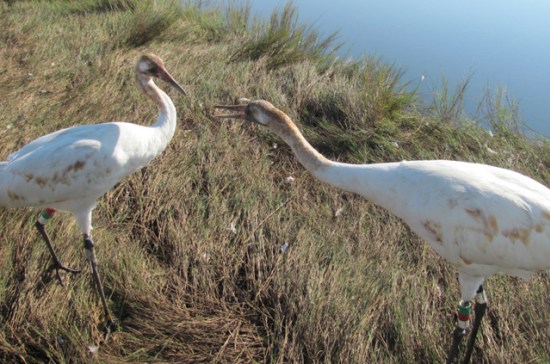
Female #16-10 gets nipped when she gets too near troublemaker #17-10. Photo: Eva Szyszkoski
Spring 2011: She remained at the Chass pen site with #15-10 several days after their three flockmates left on April 4. The last two in the Class of 2010 to migrate, #16-10 and #15-10 finally left on Sunday, April 17. They roosted that night in Thomas County, Georgia. With favorable winds, they resumed migration the next day, April 18, at 9:15 a.m. and landed around 5:15 p.m. in Cherokee County, AL. They eluded tracker Eva the next morning (see Eva’s report about that) and were not detected again until May 8, when Eva detected them in flight near Necedah NWR at 11:42 a.m. At 5:00 p.m. Eva saw them circling over a lake and they landed soon after.
Spring 2012: Female #16-10 was last observed with sandhill cranes in Ottawa County, Michigan on May 6, 2012.
Click here to jump to the top of this page.
Crane #17-10
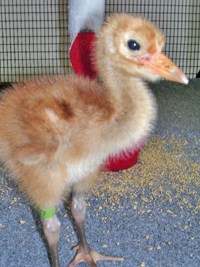
Sex: Male
Hatch Date: May 26, 2010
Personality and Characteristics: A story about his parents: It was very early in my crane career at Patuxent when captive “B11” female laid her first fertile egg. In the early years of the crane program at Patuxent, the birds could not produce fertile eggs without assistance. It was discovered that the Whooping cranes need to remain full-winged in order to breed naturally, so we put top-netting over the pens and did not clip their wing feathers. B11 was the first pair that had the opportunity to be naturally fertile and in 1991 laid their first fertile egg. I can’t describe the great excitement at Patuxent when that first chick hatched. An important milestone had been achieved. B11 pair has since produced many chicks for release. In 2010 they are the parents of #17-10. – Jane Chandler, Patuxent WRC
Notes from “Flight School” at Necedah NWR in Wisconsin: Chick #17-10 left the “hatchery” and “Ground School” in Maryland and arrived by airplane at Necedah NWR in Wisconsin on July 9 with other cohort 2 chicks. (What was his age on that day?) This group will live at “Canfield site” until the two cohorts join together when they are a bit older. Male #17-10 got a clean bill of health at his arrival health check. He was glad to be set free in Canfield pen with the other new arrivals and took off to explore and find tasty bugs and frogs. Later he joined the other chicks in the shade to escape the hot Wisconsin sun.
Even though he’s the youngest bird, #17-10 is fairly independent. “But he’s not like #2-10, who doesn’t want to be bothered, or #3-10 who thinks she’s Big Stuff, or #10-10 (Zoey), who’s probably off in la-la land as you read this. He just likes the outdoors every bit as much as #15-10 (Louis) does. Even when he was just a little chick being walked, he always ran around holding out his bitty wings, as if to say, ‘Look, I’m flying like a big kid!’ It was always fun to see him and #15-10 (Louis) running around together. However, #17-10 is a little more daring. He’s not afraid to go off in the brush to explore what’s on the other side. A lot of times when we let the birds out of their flooded dry pen to rest on the grass runway, #17-10 would be off in the marsh with #10-10 (Zoey), scoping things out. He can be one of the last birds to go back in the pen. It’s not because he hates being bossed around by the costume, but because he’s not done exploring yet!” Geoff’s personal name for #17-10 is Bill.
When the costumes were releasing the Cohort One group to fly with the ultralight on September 14, #17-10 and #10-10 were watching from inside the pen, eager for their turn. They somehow sneaked out when the handlers weren’t looking and took off with the older birds! Both flew the entire 25 minutes with the older birds. Well done, #17-10
For the first few times all 13 birds finally mixed together on the runway outside the pen, this daring young male didn’t take kindly to #1-10, #3-10, #4-10, and #6-10! He didn’t care for the no-nonsense #2-10 either, which could be a mistake because #2-10 is the top bird of all. Will his daring get him into trouble?
First Migration South, Led by Ultralight Airplane: Find day-to-day news here. Chick #17-10 left Necedah NWR on his first migration on October 10, 2010 but turned back shortly after take off to the first pen site he had known when he arrived in Wisconsin. #17-10 had landed. Geoff waited with #17-10 until #9-05 flew over to defend his territory and chased #17-10 away. The young bird landed on the top net! After fruitlessly trying to convince #17-10 to get off the top net, Brooke finally took it down. Hot and tired, #17-10 gratefully headed for a drink. Then he made the 23-mile trip in a crate by road. Find day-by-day news about the flock’s migration and read more about #17-10 below.
Oct. 17: Crane #17-10 was a loyal follower of the trike that led him from takeoff today. Pilot Joe said, “Numbers 1-10 and 17-10 locked onto my wing and the farther we went, the more faithful they became. Brooke and Richard struggled with the rest.”
All Days: Crane #17-10 gave a great performance, a loyal and dependable follower!
Day 63, Dec. 11: Yesterday was the last time all ten birds will fly together as a group. Today #16-10 and the other four birds that will winter at Chassahowitzka NWR flew 86 miles closer to their final destination! They’re now in Gilchrist County, with only two more flights to go! (They would have to wait for their next flight until January 14, 2011 due to reason’s beyond the team’s control.)
Day 72, Jan. 14: Finally in the air again! After so many days in the pen, the Chass Five gave pilots Joe and Richard a rodeo before they got on course to Marion County and the flyover arrival celebration. One more flight gets them to their winter home!
Day 73, Jan. 15: First Migration complete!
Winter at the Chass Release Pen: Of the five Chass youngsters, male #17-10 “is the troublemaker”, reports Eva. “He’s at the top of the social structure and won’t let the others forget it! He’s even started challenging the costume!” Eva is watching over the cranes and will track them as they migrate on their own, back to their Wisconsin home.
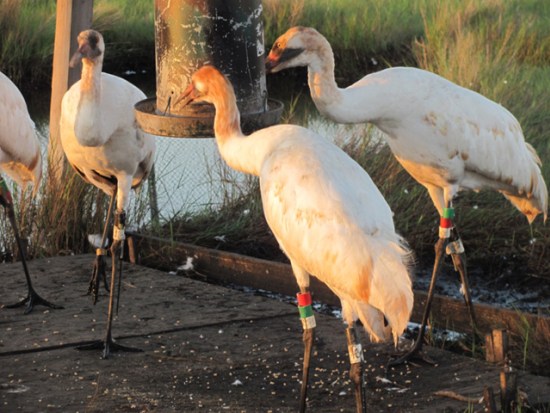
Male #17-10 is the dominant chick at Chass. Identify #17-10 by looking at the band colors! Photos Eva Szyszkoski
In early March, Eva noticed #17-10 had a sore leg. He did not want to stand on it. “We don’t know what happened to him to cause this, but I can’t see anything visibly wrong with the leg, so he probably tweaked a muscle or something,” said Eva. The good news: “We only medicated him 6 times but even the next day after I noticed it was lame, it was already getting better.”
Spring 2011: He began his first northward migration on April 4 from the Florida pen site with flock mates #3-10 and #9-10! PTT readings for that night put them in Terrell County, Georgia, about 240 miles from Chass. The second stop (night of 5 April) was in Alabama, about 100 miles NW of their first stop. After further stops in Clark County, IN, Livingston County, IL and Lee County, IL, Cranes #3-10, #9-10 and #17-10 were confirmed — still together — at their 6th migration stop (Sauk County, Wisconsin) on April 15. They moved a little south again before officially completing migration.
Fall 2011: Crane #17-10 wintered with #9-10 in Levy/Marion County, Florida.
Spring 2012: Crane #17-10 was reported alone in Sauk County, Wisconsin on April 4, so he spilt from #9-10 at some point between March 8 and April 4. He remained in Sauk County through at least April 27. He was next discovered in Juneau County, Wisconsin, with DAR juvenile #19-11. These two remained together through most of May and then split up when #17-10 moved to the refuge, where he was observed with various cranes throughout the summer.
Fall 2012: Crane #17-10 migrated south to the same location in Marion/Levy Counties in Florida.
Spring 2013: He was confirmed back on the Necedah NWR in Wisconsin on April 5. He soon joined with #W1-10 (who had split from #34-09 earlier). But on August 20 his remains were collected on his summering territory. Trackers had data that showed his death likely had happened between July 2 and July 23. He was defenseless as he was in molt (the process where new feathers grow in and replace old feathers, making the bird flightless during the molt time).
Click here to jump to the top of this page.
Group Two – Direct Autumn Release (DAR) Whooping cranes
Crane #18-10
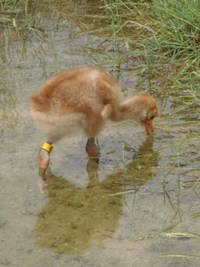
Sex: Male
Hatch Date: May 24, 2010
Personality and Characteristics: “Nacho” was this chick’s baby name after hatching at ICF. First of the DAR chicks to fledge (August 15).
“He has always been the oldest and for a while, was the biggest. Even though he’s been out-sized, he still comfortably holds the title of dominant bird. He seems to be the responsible one, leading the others to good foraging grounds. We have likened him to a high school quarter back; he’s likable, popular, and the top dog,” reports Jen.
The eleven DAR (Direct Autumn Release) Whooping Crane chicks were released October 25 on the Necedah National Wildlife Refuge (NWR). The young cranes learn the migration route from following older cranes. Biologists from ICF and the U.S. Fish & Wildlife Service are tracking the released DAR cranes using radio telemetry, picking up radio signals emitted from leg transmitters on the birds. The young DAR cranes are currently still on the refuge, but as they begin the migration south trackers will be monitoring the birds’ movements.
Sadly, #18-10 was killed on the morning of October 30 on Necedah NWR. He and three other DAR juveniles, two adult whooping cranes, and some sandhill cranes were near a small wet depression surrounded by reed canary grass. An unknown predator attacked the group, resulting in a bleeding scratch on the head of #20-10 and death of #18-10.
Click here to jump to the top of this page.
Crane #19-10
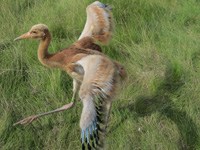
Sex: Male
Hatch Date: May 27, 2010
Personality and Characteristics: “Pepper Jack” was this chick’s baby name after hatching at ICF. He was second in the group to fly; he fledged on August 16. How many days of age was he then?
“Crane #19-10 has always been stubborn, intelligent, and very independent. He seems to know that the costumes are not his parents. He has always been a willful child, doing exactly opposite of what we wanted him to do. But he’s smart enough to know what’s good for him. He knows his place among the chicks is pretty high, so he doesn’t go around pushing the issue, but he likes to challenge the adult cranes and the costumes nearby as he tries to establish a higher place in the hierarchy reports Jen.
The eleven DAR (Direct Autumn Release) Whooping Crane chicks were released October 25 on the Necedah National Wildlife Refuge (NWR). The young cranes learn the migration route from following older cranes. Biologists from ICF and the U.S. Fish & Wildlife Service are tracking the released DAR cranes using radio telemetry, picking up radio signals emitted from leg transmitters on the birds.
Where is Pepper Jack? Crane #19-10 left the refuge on November 1, reported tracker Eva. “Unfortunately, I lost his signal about 1.5 hours before sunset around Richland Center, WI and could not locate him again. Tracker Jen went down there the next morning in case he got up in the air, but she also did not detect him. We will have to wait for a flight to search for him or hope that he moves somewhere and is reported by somebody. Until then, we can only cross our fingers and hope he is OK. He was not with any other Whooping cranes (at least none with working transmitters). Because of the direction he headed in and the chicks behavior since release, I do not think he was with any sandhills either.
Migration History
Fall 2010: “Wild Child” #19-10 DAR left Nov. 23 but was was missing in action until Dec. 2 when trackers caught up with him. Tracker Eva joyfully reported: “I found #19-10 DAR today! He is with adult pair #11-02 and #30-08 in Vermillion County, Indiana.” Hooray for the older crane pair to show Pepper Jack the way!
They were foraging in snowy cornfields. Adults #11-02 and #30-08 had claimed the DAR introduction site at Necedah National Wildlife Refuge as their territory, so Pepper Jack had followed them around and knew them well. They resumed migration and were in Cherokee County, Alabama but were gone when the location was checked on February 1, 2011. The three cranes were next reported in Madison County, Alabama at least through February 14, along with cranes #37-09 (DAR), #25-10 (DAR) and #27-10 (DAR).
Spring 2011: Left Madison County, Alabama sometime between Feb. 18-22 in a group with #11-02 and #30-08 and cranes #37-09 (DAR), #25-10 (DAR) and #27-10 (DAR). They were reported in Crawford County, IL on March 8-10 and Mar. 14. Minus the pair #11-02/#30-08, the group was still there March 16 and completed migration to Necedah NWR by March 21.
Fall 2011: Wintered in Greene County, Indiana with #25-10 (DAR).
Spring 2012: He began migration from wintering location in Greene County, Indiana, on March 16-18. Then was found at Necedah NWR on March 26, then moved up to Marathon County briefly in mid April before returning to Necedah. He did a few more trips between Marathon and Juneau Counties before settling in Marathon County for the summer.
Fall 2012: Male #19-10 DAR was photographed March 12 at Goose Pond fish and Wildlife Area in Greene County, Indiana. The cranes’ leg bands identify them as #19-10 DAR, male #12-02, female #19-04 and this pair’s sub-adult offspring #W1-12. He was confirmed back on Necedah NWR on April 1.
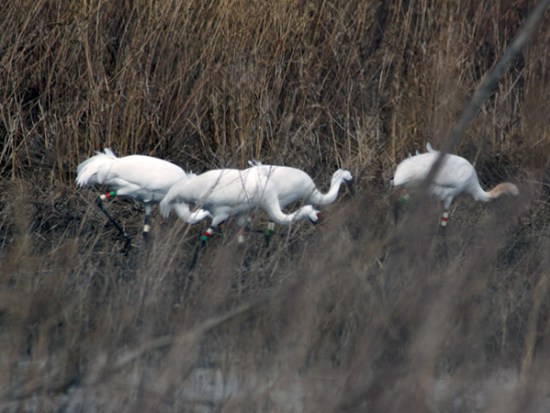
Photo: Steven Smith
Spring 2013: Completed migration March 30.
Fall 2013: He moved south from Marathon County to Juneau County before beginning migration on November 10. He was found in Greene County, Indiana, on November 13. He remained in Greene County throughout the winter with pair #12-02 & #19-04 despite abnormally cold temperatures there.
Spring 2014: He was confirmed back on Necedah NWR on April 1.
Fall 2014: Migrated south and was seen in Indiana in December with cranes #29-09, #12-02 and his youngster #W3-14, and female #4-11. This group left left Greene County, Indiana, and moved south to Lawrence County, Alabama, the first week in January. They all returned again to Greene County, Indiana on February 7, 2015, where they remain.
Fall 2015: Male #19-10 DAR was confirmed in Greene County, Indiana by November 12 after migrating sometime within the two previous weeks. Several other whoopers from the eastern flock were also in Greene County, IN.
Spring 2016: Male #19-10 DAR returned to central Wisconsin for the Summer and spent most of the summer in Winnebago County and Adams County, where he began associating in September with female #6-15.
Fall 2016: Male #19-10 DAR was still in Juneau County, WI. as November began but migrated in December to Greene Co, IN. and wintered at Goose Pond. He lost his mate (#4-11) to illegal gunshot over the New Year Weekend.
Spring 2017: Male #19-10 DAR returned alone to Juneau Co., Wisconsin after his mate #4-11 was found shot at their winter territory in Greene Co., Indiana.
During Bev Paulan’s aerial survey on July 20th she noted that #19-10 DAR had found a new mate, or at least was associating with a new female, #32-09 DAR.
Fall 2017: 19-10 and new mate 32-09 remained together and migrated to Goose Pond Fish and Wildlife Area in Indiana by early December.
Spring 2018: 19-10 and 32-09 returned to Juneau County Wisconsin, and began nesting in early May. One egg was removed to be captive reared, and the other egg was found broken in early June. No chicks were observed for this pair. Afterwards, 19-10 was seen alone at Necedah National Wildlife Refuge for the rest of the summer.
Fall 2018: In mid-December, 19-10 showed up at Goose Pond Fish and Wildlife Area in Indiana- but rather than being with mate 32-09, he was associating with pair 9-05 and 13-03.
Spring 2019: 19-10 was first seen at his territory in Juneau County, Wisconsin in April, and he was now with W18-15! Hopefully this pair will nest and stay together!
19-10 and new mate W18-15 were first seen nesting on April 23. Chick W9-19 hatched in late May.
W18-15 disappeared at the end of June, and 19-10 continued to raise W9-19 alone, but unfortunately, the chick was lost at the end of July. 19-10 remained alone in his territory for the rest of the summer.
Fall 2019: After 19-10 tried to raise his chick alone, he spent the summer on his territory in Juneau County. He eventually migrated south to Goose Pond at the beginning of November. He spent the winter here with other whooping cranes.
Spring 2020: 19-10 returned to Wisconsin at the end of March. This year he returned with a new mate female 7-11. The two began nesting and hatched one chick, W6-20. Unfortunately, the chick did not make it. 19-10 and 7-11 went their separate ways and have spent the summer alone.
Fall 2020: 19-10 was seen at his wintering area at Goose Pond FWA, Indiana at the end of October with a small group of whooping cranes. He reunited with female 7-11 and has been also been seen with her in a large group of whooping cranes. Hopefully, they will migrate back and nest together once again.
Spring 2021: 19-10 and 7-11 migrated together and were seen in Meadow Valley in Wisconsin by late March and were incubating 2 weeks later! Their nest failed, likely due to predation by a coyote or wolf. Since then, they have been spending their time in their home territory.
Fall 2021: This fall 7-11 showed up to her wintering grounds without her mate 19-10. He was last seen in Juneau County, Wisconsin on the 13th of July.
Click here to jump to the top of this page.
Crane #20-10
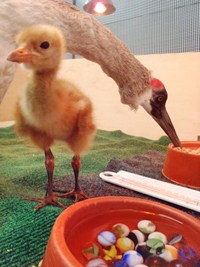
Sex: Male
Hatch Date: May 31, 2010
Personality and Characteristics: “Gouda” was this chick’s baby name after hatching at ICF; he fledged on August 19.
Crane #20-10 is one of the largest birds in our flock. He has never been as easy with his place in the hierarchy as his buddies #18-10 and #19-10. He often challenges other birds. Being one of our better fliers, he is often hanging around with #18-10, #19-10, and #20-10, reports Jen.
The eleven DAR (Direct Autumn Release) Whooping Crane chicks were released October 25 on the Necedah National Wildlife Refuge (NWR). The young cranes learn the migration route from following older cranes. Biologists from ICF and the U.S. Fish & Wildlife Service are tracking the released DAR cranes using radio telemetry, picking up radio signals emitted from leg transmitters on the birds.
On October 30 an unknown predator attacked a group of cranes on Necedah NWR. The group included #20-10 and three other DAR juveniles, two adult whooping cranes, and sandhill cranes. Male #20-10 got a bleeding scratch on the head but #18-10 was killed.
By Nov. 6 the large group of nine birds had been settling into a routine and feeding in cornfields just south of the refuge during the day, reported Eva. They are usually with older birds #6-05, #6-09 and #38-09 (DAR) and return to the refuge in the evening.
As they begin the migration south trackers will be monitoring the birds’ movements. Watch for news below!
Migration History
Fall 2010, First Migration: Began migration November 23, following older Whooping cranes who know the route. In fact, DAR chicks #20-10, #23-10, #24-10, #26-10, and #28-10 all stayed together and were led by experienced adults #6-05 and yearlings #6-09 and #38-09 DAR. This large group of eight spent some time in Muscatatuck National Wildlife Refuge before once again escaping the cold snows of Indiana.
WCEP trackers recorded the five DAR chicks and the three older whoopers in Hamilton County, TN when they roosted there on December 10th. On December 13th the group of eight cranes left this location. The three older birds later returned, but no further reports came for the five DAR juveniles until December 30, 2010, when hunters found three of them dead from gunshots just west of Albany, Georgia. The three shot cranes were DAR chicks #20-10, #24-10 and #28-10.
The landowner reported the cranes had been in the area for a few weeks before they were found dead. Since the deaths, two Whooping Cranes, presumed to be the other two DAR birds of the group of five, had been sighted in fields nearby.
The U.S. Fish and Wildlife Service and the Georgia Department of Natural Resources and others are investigating the shooting of these endangered birds, and a reward is offered for information leading to arrest of the shooters. The public is asked to report any tips. Contact U.S. Fish and Wildlife Service Special Agent Terry Hasting at 404-763-7959 (ext. 233).
Updates will appear here when there’s further news.
Click here to jump to the top of this page.
Crane #22-10
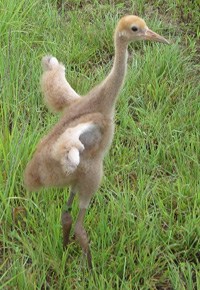
Sex: Female
Hatch Date: June 9, 2010
Personality and Characteristics: “Havarti” was this chick’s baby name after hatching at ICF. She was one of the smallest in size and did not fly until later than the others.
On September 27 Jen reported: “Everyone has fledged. We’re still not really sure about #22-10, but we know she can at least fly a little bit. We find that she flies out of the day pen on a regular basis. We hope that we’ll see her flying circles around site three within the next couple weeks, or we might have to take her back under our wing and find a different place for her.”
On October 2 Jen reported: “Smallest of the 2010 DAR flock, she has been the most timid flier so far. She recently proved to us that she can fly — and fly very well with the others. She has always been very independent and very focused on hunting larger food than the other chicks. She was the first to catch a snake!”
The 11 DAR (Direct Autumn Release) Whooping Crane chicks were released October 25 on the Necedah National Wildlife Refuge (NWR). The young cranes learn the migration route from following older cranes. Biologists from ICF and the U.S. Fish & Wildlife Service are tracking the released DAR cranes using radio telemetry, picking up radio signals emitted from leg transmitters on the birds.
By Nov. 6 the large group of nine DAR birds had been settling into a routine and feeding in cornfields just south of the refuge during the day, reported Eva. They are usually with older birds #6-05, #6-09 and #38-09 (DAR) and return to the refuge in the evening.
As they begin the migration south trackers will be monitoring the birds’ movements. Watch for news below!
Migration History
Fall 2010, First Migration: Many of the eastern flock began migration from Wisconsin on November 20, and so did Crane #22-10 DAR (along with #25-10 DAR and #27-10 DAR). These three young DAR birds left without adult supervision! How would they know where to go? Luckily, veteran migrators #13-03 and #18-03 caught up with the youngsters along the Mississippi River, and the group rejoined the migration corridor. On Nov. 24 they were in Greene County, Indiana, in the same area as one of the family groups from the flock. She continued migrating south with other cranes leading the way, and was last reported January 23 in Cherokee County, Alabama with several other migrating Whooping cranes from the flock. One of the group, #12-04, was shot dead shortly thereafter. Crane #22-10 (DAR) was not with the group when they were next found Feb. 4 in Madison County, Alabama.
Sad news came Feb. 18, 2011 when it was announced that Federal investigators had discovered her remains on the Alabama-Georgia border —about 1/4 mile from where #12-04 was shot a few weeks earlier. Officials believe the two deaths are linked, and are working hard to find the perpetrator. The reward for shooting these endangered whooping cranes now stands at $23,250. The money was given by 18 non-governmental organizations, federal agencies, and private individuals for additional information on the deaths of the two whooping cranes leading to successful prosecution of the perpetrator(s).
Click here to jump to the top of this page.
Crane #23-10
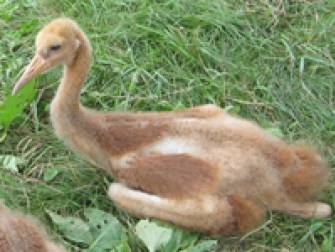
Sex: Female
Hatch Date: June 10, 2010
Personality and Characteristics: “Ricotta” was this chick’s baby name after hatching at ICF. She was fifth in the group to fly; her fledge date was August 31.
She is very smart, and sometimes slightly tricksy: she’ll do anything to get treats without having to do the work for them. She’ll even steal other birds’ finds. She is a very good flier, reports Jen.
The 11 DAR (Direct Autumn Release) Whooping Crane chicks were released October 25 on the Necedah National Wildlife Refuge (NWR). The young cranes learn the migration route from following older cranes. Biologists from ICF and the U.S. Fish & Wildlife Service are tracking the released DAR cranes using radio telemetry, picking up radio signals emitted from leg transmitters on the birds.
By Nov. 6 the large group of nine DAR birds had been settling into a routine and feeding in cornfields just south of the refuge during the day, reported Eva. They are usually with older birds #6-05, #6-09 and #38-09 (DAR) and return to the refuge in the evening.
As they begin the migration south trackers will be monitoring the birds’ movements. Watch for news below!
Migration History
Fall 2010, First Migration: Began migration November 23, following older Whooping cranes who know the route. In fact, DAR chicks #20-10, #23-10, #24-10, #26-10, and #28-10 all stayed together and were led by experienced adults (#6-05 and yearlings #6-09 and #38-09). This large group of eight spent some time in Muscatatuck National Wildlife Refuge before once again escaping the cold snows of Indiana and moving along.
WCEP trackers recorded the five DAR chicks and the three older whoopers in Hamilton County, TN when they roosted there on December 10th. On December 13th the group of eight cranes left this location. The three older birds later returned, but no further reports came for the five DAR juveniles until December 30, 2010, when hunters found DAR chicks #20-10, #24-10 and #28-10 dead under suspicious circumstances near Albany, Georgia. The deaths are being investigated by legal and wildlife officials. After the deaths, two Whooping cranes, presumed to be #23-10 DAR and #26-10 DAR, were sighted in fields adjacent to where their three flock mates were killed but moved on to Calhoun County, Georgia. The two were last detected there on January 22, 2011.
Spring 2011: Crane #23-10 (with #26-10) departed their wintering location in Georgia sometime between March 8 and March 24 or 28. As of April 27 they were believed to be still in southern Indiana, on spring migration. The two apparently continued migration from Scott County, IN on April 30. On May 2, Eva reported, “Today I heard DAR #23-10 and #26-10 on the refuge! They may have arrived yesterday, but we don’t know for sure.” Hooray!
Fall 2011: DAR #23-10 (with #26-10) wintered at an unknown location. They were last detected headed south from southern Tennessee in December.
Spring 2012: DAR #23-10 and DAR #26-10 were reported in Jackson County, Indiana in early March after wintering at an unknown location. They completed migration to Wisconsin on March 27, where they then split. DAR female #23-10 began associating with DAR male #21-10 by early June.
Fall 2012: DAR #23-10, still with DAR male #21-10, migrated with him to his wintering location at the Hiwassee WR in Tennessee. When he died during the winter, she began associating with DAR male #37-07 (the flock’s Michigan bird).
Spring 2013: Female #23-10 DAR began migration on March 12 from Hiwassee WR in Tennessee with male #37-07 DAR but she split from him during spring migration and he went back to Michigan. By the end of April she was in Wisconsin with male #38-09 DAR (who also recently split with his previous mate). Later she was with male #8-10, but that didn’t last.
Fall 2013: Female #23-10 DAR was with male #8-10 in the fall and early winter. She was last detected in Greene County, Indiana, on December 31. Meanwhile, #8-10 showed up at the St. Marks pen in Florida without her, and trackers have had no further information on her location.
Spring 2014: Female #23-10 DAR has reappeared! She was confirmed back on Necedah NWR April 4, together once again with male #8-10 on his territory.
Fall 2014: Female #23-10 DAR began migration from the Necedah area between Nov. 10-26. She wintered with her new mate #4-08 and also with male crane #6-09 in Greene County, Indiana. The pair made a short trip (less than two weeks) to Wheeler NWR, Alabama, in early January.
Spring 2015: Migrated back to Necedah NWR.
Fall 2015: Female #23-10 migrated south in November to Greene County, Indiana, where she was now associating with male #18-09 and several other whoopers.
Spring 2016: Female #23-10 DAR returned to Juneau County, Wisconsin, with male #18-09. Their first nest failed but they were observed on a renest May 6. Their new chick, #W20-16, hatched on June 5 but did not survive into the summer.
Fall 2016: Female #23-10 DAR migrated to Indiana and spent the winter in Greene County with several other Whooping Cranes.
Spring 2017: Female #23-10 DAR returned to Juneau County, Wisconsin. She is now with parent-reared male PR #24-13.
Summer 2017: At the end of the summer, 23-10 stopped associating with 24-13 and began associating male 13-02. 24-13 disappeared around this time.
Fall 2017: 23-10 migrated with 13-02. After a brief stopover at Goose Pond in Indiana, they spent the rest of the winter at his normal winter territory at Wheeler National Wildlife Refuge in Alabama.
Spring 2018: 23-10 returned to Necedah National Wildlife Refuge with 13-02 in mid-March, but shortly after arriving, she began associating with male 4-08 instead. The new pair nested in May, and chick W10-18 hatched in June! The chick survived the summer and fledged – fantastic for this new pair!
Fall 2018: In early November, the family group 4-08, 23-10, and W10-18 was seen at Goose Pond Fish and Wildlife Area in Indiana- chick W10-18 has completed their first migration!
Spring 2019: Trackers confirmed that 23-10 and 4-08 had returned to their territory at Necedah NWR and kicked out chick W10-18 to prepare to nest in early April.
23-10 and 4-08 were first seen nesting on April 15, but the eggs from their nest were collected as part of the forced renesting program. The pair did not renest.
In mid-July, 23-10 was seen associating with male 3-04 and his chick W16-19. 4-08 was not seen after that point. W16-19 disappeared but 23-10 stayed with 3-04. Will this be a new pair?
Fall 2019: 23-10 and her mate 3-04 spent the summer together on their territory at Necedah National Wildlife Refuge. At the beginning of November, the two arrived at their wintering grounds in Wayne County, Illinois. The pair remained here for the winter.
Spring 2020: 3-04 and 23-10 made their way back to Necedah by the end of March. By the end of April, the pair was suspected to be nesting, however, a Necedah biologist heard a “rattle despair call” from one of the cranes. Since then, 23-10 has not been seen and 3-04 has been spotted alone.
Click here to jump to the top of this page.
Crane #24-10
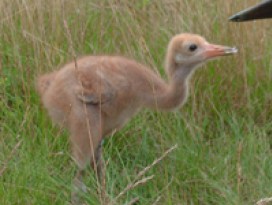
Sex: Female
Hatch Date: June 11, 2010
Personality and Characteristics: “Fontina” was this chick’s baby name after hatching at ICF. She was fourth in the group to fly; her fledge date was August 26.
Jen reports: One of the BEST fliers in the group, she started flying at an earlier age than any of the rest of the chicks. it’s almost like she enjoys showing off by making an extra circle around the field before landing. She is not very independent, though. She always stays in a group, or as close as she can get to a costumed handler. She had a bee sting on her cheekbone in early September, and she still hasn’t grown back all of her face feathers yet. We can easily identify her that way!
The eleven DAR (Direct Autumn Release) Whooping Crane chicks were released October 25 on the Necedah National Wildlife Refuge (NWR). The young cranes learn the migration route from following older cranes. Biologists from ICF and the U.S. Fish & Wildlife Service are tracking the released DAR cranes using radio telemetry, picking up radio signals emitted from leg transmitters on the birds.
By Nov. 6 the large group of nine DAR birds had been settling into a routine and feeding in cornfields just south of the refuge during the day, reported Eva. They are usually with older birds #6-05, #6-09 and #38-09 (DAR) and return to the refuge in the evening.
As they begin the migration south trackers will be monitoring the birds’ movements. Watch for news below!
Migration History
Fall 2010, First Migration: Began migration November 23, following older Whooping cranes who know the route. In fact, DAR chicks #20, #23, #24, #26, and #28-10 all stayed together and were led by experienced adults (#6-05 and yearlings #6-09 and #38-09 DAR). This large group of eight spent some time in Muscatatuck National Wildlife Refuge before once again escaping the cold snows of Indiana.
WCEP trackers recorded the five DAR chicks and the three older whoopers in Hamilton County, TN when they roosted there on December 10th. On December 13th the group of eight cranes left this location. The three older birds later returned, but no further reports came for the five DAR juveniles until December 30, 2010, when hunters found three of them dead from gunshot just west of Albany, Georgia. The three shot cranes were DAR chicks #20-10, #24-10 and #28-10.
The landowner reported the cranes had been in the area for a few weeks before they were found shot. Since the deaths, two Whooping Cranes, presumed to be the other two DAR birds of the group of five, were sighted in fields near the site of the shooting.
The U.S. Fish and Wildlife Service and the Georgia Department of Natural Resources and others are investigating the shooting deaths of these endangered birds, and a reward is offered for information leading to arrest of the shooters. The public is asked to report any tips. Contact U.S. Fish and Wildlife Service Special Agent Terry Hasting at 404-763-7959 (ext. 233).
Updates will appear here when there’s further news.
Click here to jump to the top of this page.
Crane #25-10
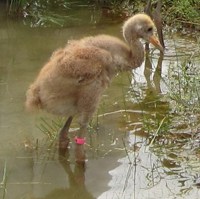
Sex: Male
Hatch Date: June 13, 2010
Personality and Characteristics: “Queso” was this chick’s baby name after hatching at ICF. He began to fly on September 4! How many days old was he then?
As the summer turned to fall, it was clear that this bird is the big rebel. He is almost never with the group. Jen says they think of him as the lone wolf.
The eleven DAR (Direct Autumn Release) Whooping Crane chicks were released October 25 on the Necedah National Wildlife Refuge (NWR). The young cranes learn the migration route from following older cranes. Biologists from ICF and the U.S. Fish & Wildlife Service are tracking the released DAR cranes using radio telemetry, picking up radio signals emitted from leg transmitters on the birds.
By Nov. 6 the large group of nine DAR birds had been settling into a routine and feeding in cornfields just south of the refuge during the day, reported Eva. They are usually with older birds #6-05, #6-09 and #38-09 (DAR) and return to the refuge in the evening.
As they begin the migration south trackers will be monitoring the birds’ movements. Watch for news below!
Migration History
Fall 2010, First Migration: Many of the eastern flock began migration from Wisconsin on November 20, and so did Crane #25-10 DAR (along with #22-10 DAR and# 27-10 DAR). These three young DAR birds left without adult supervision! How would they know where to go? Luckily, veteran migrators #13-03 and #18-03 caught up with the youngsters along the Mississippi River, and the group rejoined the migration corridor. On Nov. 24 they were in Greene County, Indiana, in the same area as one of the family groups from the flock. Young #25-10 (DAR) was then reported in Cherokee County, Alabama until at least January 26, along with crane pair #11-02/#30-08 and also #22-10 (DAR), #27-10 (DAR), #19-10 (DAR) and #37-09 (DAR). The group moved to Madison County, Alabama, where trackers found them on Feb. 4. They remained at least through Feb. 14.
Spring 2011: Left Madison County, Alabama sometime between Feb. 18-22 in a group with #11-02 and #30-08 and cranes #37-09 (DAR), #19-10 (DAR) and #27-10 (DAR). They were reported in Crawford County, IL on March 8-10 and Mar. 14. Minus the pair #11-02/#30-08, the group was still there March 16 and completed migration to Necedah NWR by March 21. The three DAR youngsters moved by April 2 to Dodge County’s Horicon Refuge with #28-08.
Fall 2011: Wintered in Greene County, Indiana with #19-10 (DAR).
Spring 2012: Crane #25-10 DAR departed Greene County on migration on March 27. He began hanging out with #19-09 by mid May. These two males stayed on and near Necedah NWR throughout the summer.
Fall 2012: Males DAR #25-10 and #19-09 were reported on the Upper Mississippi River National Wildlife and Fish Refuge in LaCrosse County, Wisconsin on October 25 and apparently began migration from this location. They were discovered in Gibson County, Indiana, on Nov. 21, where they remained throughout the winter. Also present there were pairs #5-12/22-07 and 16-02/16-07.
Spring 2013: #25-10 DAR and #19-09 began spring migration from their wintering location in Gibson County, Indiana, between April 1 and 3 and were not yet documented back on Necedah NWR as of April 5.
Fall 2013: #25-10 DAR and #19-09 began migration prior to November 9 when the two were reported at their wintering site in Gibson County, Indiana. They remained through at least March 7, 2014.
Spring 2014: #25-10 DAR was confirmed on the Necedah NWR on 2 April. He had last been detected on his wintering grounds in Gibson County, Indiana, on 30 March.
Fall 2014: Male #25-10 DAR wintered again in Gibson County, Indiana with male #19-09 and new pair #12-09/#14-09.
Spring 2015: Male #25-10 DAR and male #19-09 were first reported at Necedah NWR on March 31. They spent the spring and summer there.
Fall 2015: Pals #25-10 DAR and #19-09 migrated to their wintering grounds in Lawrence County, Illinois, on Nov. 23.
Spring 2016: Males #25-10 DAR and #19-09 migrated back to Wisconsin in April and again spent the spring and summer at Necedah NWR.
Fall 2016: On November 11, male #25-10 DAR and his friend #19-09 were reported on wintering grounds in Gibson and Knox County, Indiana.
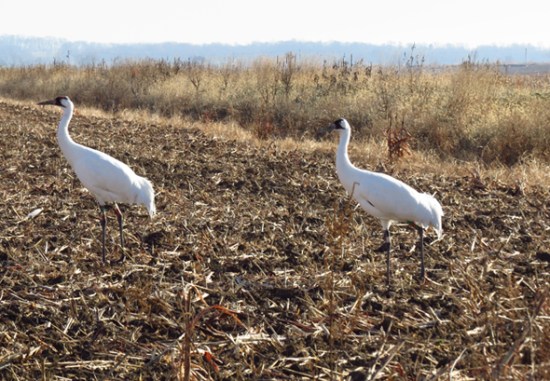
25-10 and his buddy 19-09. photo: Volunteer tracker, John Pohl
Spring 2017: Males #25-10 DAR and #19-09, still together as best buddies, returned to Juneau County, Wisconsin for the summer.
Fall 2017: In early November, 25-10 and 19-09 returned to Gibson County, Indiana where they have spent winters in the past.
Spring 2018: 25-10 and 19-09 were confirmed back at Necedah National Wildlife Refuge in April. The two buddies spent the summer together again.
Fall 2018: At the end of October, 25-10 and 19-09 returned to Gibson County, Indiana for the winter.
Spring 2019: Pals 25-10 and 19-09 had returned to their Necedah NWR territory by early April.
Fall 2019: 19-09 and best friend 25-10 spent the summer on their territory at Necedah. They arrived on their wintering grounds in Gibson County, Indiana, is mid-October. They spent the winter here together.
Spring 2020: 19-09 and 25-10 made their way back to Necedah in April. The two have spent the summer here together.
Fall 2020: 19-09 and 25-10 left their territory at Necedah and were first seen on their wintering grounds in Gibson County, Indiana in late October.
Spring 2021: 25–10 and 19–09 arrived back at their territory in Necedah National Wildlife Refuge in mid-March. As usual, they have spent the summer together.
Fall 2021: This fall has been an exciting one for 19-09 and 25-10! They migrated down to Gibson County, Indiana where they met up with 37-07, 6-15, and captive reared chick 84-21. In a surprising turn of events, 19-09 and female 6-15 have been associating closely and are treating 84-21 as their chick. 25-10 has not been seen associating closely with any other whooping cranes, although he sometimes is part of the bigger group along with 42-09 and 37-07.
Spring 2022: 25-10 was seen on his northward migration with 42-09, 84-21, and 37-07. No longer paired with 19-09, 25-10 has been living the life of a bachelor, although he was most recently seen associating with W11-21.
Fall 2022: 25-10 moved around a bit this summer and was often tricky to find. He migrated to his previous wintering area in Gibson County, Indiana and has been regularly seen with female 84-21. We hope the two will stick together through the winter and migrate back to Necedah together in 2023!
Spring 2023: 25-10 was last recorded in Gibson County, Indiana in mid-February alongside 84-21 and 27-14. However, since returning to Necedah National Wildlife Refuge in early May, he has only been seen alone or with female W1-06. We hope 25-10 can find a mate next year!
Fall 2023: 25-10 spent his summer at Necedah NWR before heading off on his winter migration this year. On his path to his usual wintering grounds in Gibson County, Indiana, he made a quick stop in La Salle County, Illinois in mid-October. He was spotted in Indiana just two days after his stop and has since been reunited with his former acquaintance, 84-21. The two have continued to forage and explore their wintering grounds together, and we are eager to see if they will become a pair in the spring!
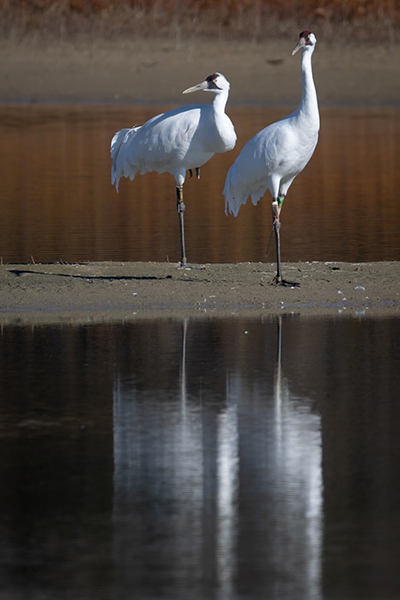
Click here to jump to the top of this page.
Crane #26-10
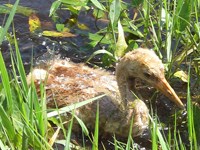
Sex: Male
Hatch Date: June 14, 2010
Personality and Characteristics: “Goat” was this chick’s baby name after hatching at ICF.
Jen calls him an “A+” guy, nice guy. “We like to think of him as the gentle giant.”
The eleven DAR (Direct Autumn Release) Whooping Crane chicks were released October 25 on the Necedah National Wildlife Refuge (NWR). The young cranes learn the migration route from following older cranes. But that night he suffered an injury to his lower beak so he was returned to captivity while it healed. Crane #26-10 was re-released November 5. He joined up with the rest of his DAR group Nov. 6.
Biologists from ICF and the U.S. Fish & Wildlife Service are tracking the released DAR cranes using radio telemetry, picking up radio signals emitted from leg transmitters on the birds. The large group of nine birds (#18-10 was killed by a predator) has been settling into a routine and feeding in cornfields just south of the refuge during the day, reported Eva. They are usually with older birds #6-05, #6-09 and #38-09 (DAR) and return to the refuge in the evening.
Migration History
Fall 2010, First Migration: Began migration November 23, following older Whooping cranes who know the route. In fact, DAR chicks #20-10, #23-10, #24-10, #26-10, and #28-10 all stayed together and were led by experienced adults (#6-05 and yearlings #6-09 and #38-09 DAR). This large group of eight spent some time in Muscatatuck National Wildlife Refuge before once again escaping the cold snows of Indiana and moving along.
WCEP trackers recorded the five DAR chicks and the three older whoopers in Hamilton County, TN when they roosted there on December 10th. On December 13th the group of eight cranes left this location. The three older birds later returned, but no further reports came for the five DAR juveniles until December 30, 2010, when hunters found DAR chicks #20-10, #24-10 and #28-10 dead under suspicious circumstances near Albany, Georgia. The deaths are being investigated by legal and wildlife officials. After the deaths, two Whooping cranes, presumed to be #26-10 DAR and #23-10 DAR, were sighted in fields adjacent to where their three flock mates were killed but moved on to Calhoun County, Georgia. The two were last detected there on January 22, 2011.
Spring 2011: Crane #26-10 (with #23-10) departed their wintering location in Georgia sometime between March 8 and March 24 or 28. As of April 27 they were believed to be still in southern Indiana, on spring migration. The two apparently continued migration from Scott County, IN on April 30. On May 2, Eva reported, “Today I heard #23-10 and #26-10 on refuge! They may have arrived yesterday, but we don’t know for sure.” Hooray!
Fall 2011: Crane #26-10 (with #23-10) wintered at an unknown location. They were last detected headed south from southern Tennessee in December.
Spring 2012: DAR male #26-10 (with #23-10) were reported in Jackson County, Indiana, in early March after wintering at an unknown location. They completed migration to Wisconsin on March 27. The pair split soon after. He remained on and near the Necedah NWR throughout the summer, often observed with DAR female #27-10.
Fall 2012: DAR male #26-10 began migration south with cranes #21-10 and #23-10 on November 20-11. He was reported with these two birds in Kane County, IL on Nov. 22. Apparently he split off from them, as he was next reported alone in Henderson County, Kentucky, on November 25. He remained in this area through at least December 12, when he apparently departed to an unknown wintering location.
Spring 2013: Crane #26-10 DAR was reported on spring migration in Gibson County, Indiana on March 5, traveling with pair #27-06 and #26-09. He completed migration on or by March 30, and may have returned earlier (March 17) with #26-09 and #27-06.
Fall 2013: Crane #26-10 DAR began migration from Necedah with male #38-09 (date unknown) and was reported in Gibson County, Indiana on Nov. 14-25 — also with pairs #11/09/#15-09 and still with #38-09. Cranes #26-10 and #38-09 arrived at the Wheeler NWR in Alabama sometime before January 21. He was last confirmed there on January 29.
Spring 2014: Crane #26-10 DAR may be the eighth (and unknown) bird that joined a large group of cranes that departed Wheeler NWR in Alabama and was reported in Gibson County, Indiana, on 21 February and Lawrence County, Illinois, by 22 February. When female #7-09 completed migration to the Necedah NWR by 28 March, she was observed with a crane with a non-functional transmitter. It must have been #26-10, because he’s the new mate of #7-09.
Fall 2014: Male #26-10 DAR and mate #7-09 began migration from the Necedah area on November 16 and wintered in Gibson County, Indiana with #16-04 and #7-09.
Spring 2015: #26-10 DAR returned with mate #7-09 and the pair had an active nest by May 4 but no successful hatchings.
26-10 was last seen July 2015.
Click here to jump to the top of this page.
Crane #27-10
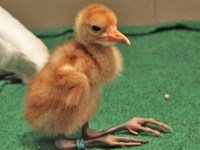
Sex: Female
Hatch Date: June 18, 2010
Personality and Characteristics: “Feta” was this chick’s baby name after hatching at ICF. By September 5 she was almost flying.
Jen says Feta is a little independent of the whole group, but she has a tendency to follow #25-10 (Queso). For a period of time, she was very sheepish. Now she has grown more confident in the group, thanks to a little extra attention from the costume.
The eleven DAR (Direct Autumn Release) Whooping Crane chicks were released October 25 on the Necedah National Wildlife Refuge (NWR). The young cranes learn the migration route from following older cranes. Biologists from ICF and the U.S. Fish & Wildlife Service are tracking the released DAR cranes using radio telemetry, picking up radio signals emitted from leg transmitters on the birds.
By Nov. 6 the large group of nine DAR birds had been settling into a routine and feeding in cornfields just south of the refuge during the day, reported Eva. They are usually with older birds #6-05, #6-09 and #38-09 (DAR) and return to the refuge in the evening.
As they begin the migration south trackers will be monitoring the birds’ movements. Watch for news below!
Migration History
Fall 2010, First Migration: Many of the eastern flock began migration from Wisconsin on November 20, and so did Crane #27-10 DAR (along with #22-10 DAR and #25-10 DAR). These three young DAR birds left without adult supervision! How would they know where to go? Luckily, veteran migrators #13-03 and #18-03 caught up with the youngsters along the Mississippi River, and the group rejoined the migration corridor. On Nov. 24 they were in Greene County, Indiana, in the same area as one of the family groups from the flock. Young #27-10 (DAR) was then reported in Cherokee County, Alabama until at least January 26, along with crane pair #11-02/#30-08 and #19-10 (DAR) as well as #22-10 (DAR), #25-10 (DAR), and #37-09 (DAR). The group moved to Madison County, Alabama, where trackers found them on Feb. 4. They remained at least through Feb. 14.
Spring 2011: Left Madison County, Alabama sometime between Feb. 18-22 in a group with #11-02 and #30-08 and cranes #37-09 (DAR), #19-10 (DAR) and #25-10 (DAR). They were reported in Crawford County, IL on March 8-10 and Mar. 14. Minus the pair #11-02/#30-08, the group was still there March 16 and completed migration to Necedah NWR by March 21.
Fall 2011: Wintered (with #14-11 DAR) near Weiss Lake (on the Georgia side mainly) in Floyd County.
Spring 2012: Crane #27-10 (DAR) and #18-09 were reported back on Necedah NWR March 11, migration complete!
Fall /Winter 2012-2013: Wintered in Greene County, Indiana.
Spring 2013: If bands were reported correctly, Crane #27-10 (DAR) was among three adult whoopers reported March 26 in a reclaimed wetland area of an Illinois quarry. “They have been loafing and feeding in the same area of the wetland for at least the last 2 days,” reported the observer. Their current location is 4 miles from the Livingston Co., IL stopover site of the ultralight-led migration south for male #6-09, one of these three birds. Perhaps he’s the leader of this trio’s journey north? All three completed migration to Necedah NWR.
Fall 2013: Crane #27-10 (DAR) began migration on November 12, likely with #6-09. She was reported in Greene County, Indiana, on November 20 where she and #6-09 remained through at least December 20. She was next reported with #6-09 and five other cranes in Rutherford County, TN on January 24, 2014. The group of seven moved south into Franklin County, TN by January 29 and apparently began migration north from this location.
Spring 2014: Female #27-10 (DAR) was confirmed on Necedah NWR on April 5 but she was no longer with male #6-09. She was last detected on the Necedah NWR, Juneau County, Wisconsin on 22 April. Her transmitter is likely non-functional.
Fall 2014: Missing. Crane #27-10 (DAR) hasn’t been seen or heard from since April 22 in Wisconsin.
Click here to jump to the top of this page.
Crane #28-10
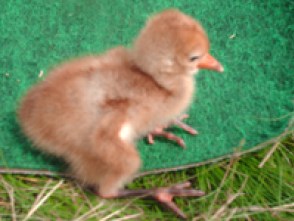
Sex: Male
Hatch Date: June 7, 2010
Personality and Characteristics: “Saganaki” was this chick’s baby name after hatching at ICF. He was the baby of the group but he was already flying at 70 days of age.
Since he’s the youngest, it’s like he has something to prove to himself or to the others by challenging everyone all the time, reported Jen. But As a baby, he was a really great cuddler. He was always brooding the costume, and if he had the chance, he would sit down with other chicks.
The eleven DAR (Direct Autumn Release) Whooping Crane chicks were released October 25 on the Necedah National Wildlife Refuge (NWR). The young cranes learn the migration route from following older cranes. Biologists from ICF and the U.S. Fish & Wildlife Service are tracking the released DAR cranes using radio telemetry, picking up radio signals emitted from leg transmitters on the birds.
By Nov. 6 the large group of nine DAR birds had been settling into a routine and feeding in cornfields just south of the refuge during the day, reported Eva. They are usually with older birds #6-05, #6-09, and #38-09 (DAR) and return to the refuge in the evening.
As they begin the migration south trackers will be monitoring the birds’ movements. Watch for news below!
Migration History
Fall 2010, First Migration: Began migration November 23, following older Whooping cranes who know the route. In fact, DAR chicks #20-10, #23-10, #24-10, #26-10, and #28-10 all stayed together and were led by experienced adults (#6-05 and yearlings #6-09 and #38-09 DAR). This large group of eight spent some time in Muscatatuck National Wildlife Refuge before once again escaping the cold snows of Indiana and moving along.
WCEP trackers recorded the five DAR chicks and the three older whoopers in Hamilton County, TN when they roosted there on December 10th. On December 13th the group of eight cranes left this location. The three older birds later returned, but no further reports came for the five DAR juveniles until December 30, 2010, when hunters found three of them dead of gunshot just west of Albany, Georgia. The three dead cranes were DAR chicks #20-10, #24-10 and #28-10.
The landowner reported the cranes had been in the area for a few weeks before they were found dead. Since the deaths, two Whooping cranes, presumed to be the other two DAR birds of the group of five, have been sighted in fields adjacent to the mortality site.
The U.S. Fish and Wildlife Service and the Georgia Department of Natural Resources and others are investigating the shooting deaths of these endangered birds, and a reward is offered for information leading to arrest of the shooters. The public is asked to report any tips. Contact U.S. Fish and Wildlife Service Special Agent Terry Hasting at 404-763-7959 (ext. 233).
Click here to jump to the top of this page.
Group Three – Wild-hatched Whooping cranes
Crane: W1-10
Sex: Female
Hatch Date: May 30/31, 2010
She was hatched in the wild to parents #9-03 and #3-04.
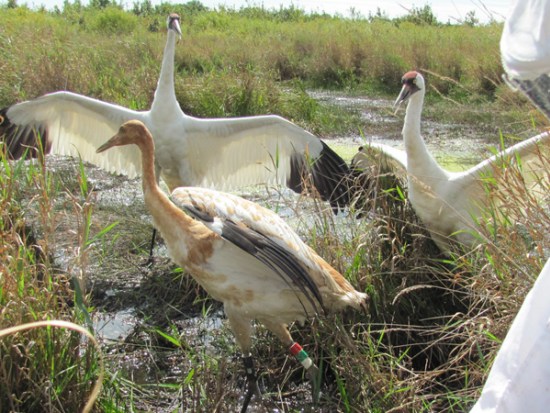
Parents 9-03 and 3-04 attempt to protect their offspring from being captured by WCEP banding team.
Notes from Necedah National Wildlife Refuge in Wisconsin:
September 14, 2010: Wild chick #W1-10 was captured and banded at the age of 107 (or 108) days. ICF tracker Eva took photos. Read Eva’s story in this slideshow!
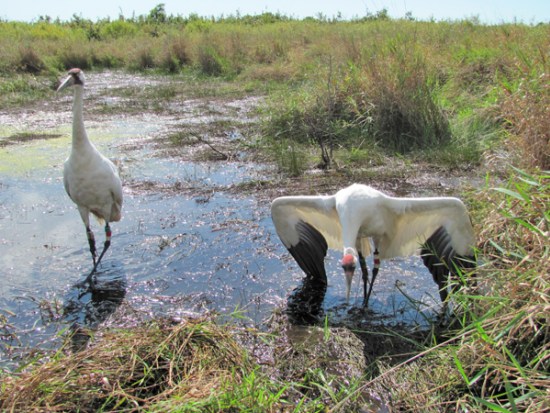
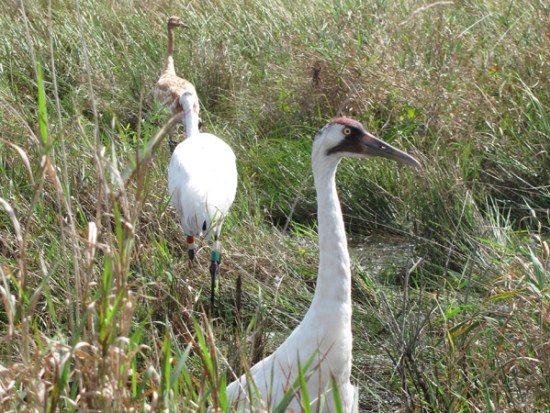
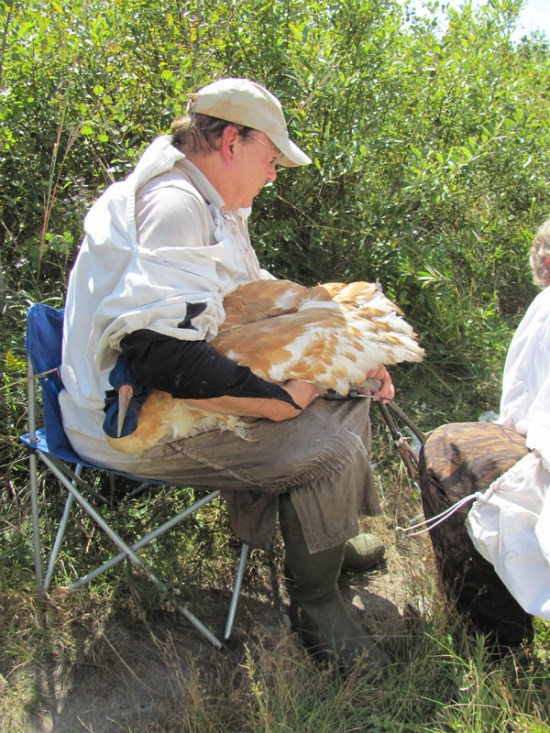
September 30: Tracker Eva said #W1-10 and her two parents #9-03 and #3-04 have been regularly leaving the refuge and flying up to 14 miles away from their territory to forage in fields. They are feeding, flying and fattening to get ready for migration!
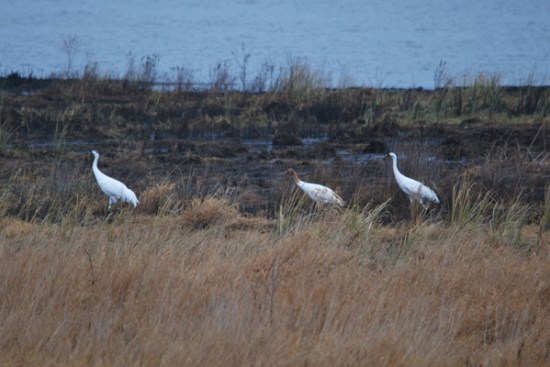
W1-10 and her parents at Necedah NWR in mid November before migration. Photo: Doug Pellerin
Most of the adult Whooping Cranes left on migration November 23, 2010. Only nine remain on or near the Necedah National Wildlife Refuge, including the family group with wild-hatched chick #W1-10.
Migration History
Fall 2010, First Migration: Led by her parents #9-03 and #3-04, chick #W1-10 began migration November 25 or 26. The family group was last detected in Lawrence County, Illinois on December 3. The family migrated safely to the parents’ previous wintering territory in Lafayette County, Florida. they were found there during an aerial survey on December 21. They showed up in Taylor County, Florida during a survey flight on January 13, 2011. Trackers tried a ground search of this location on February 9 but the area proved to be inaccessible by ground. The family was not detected on an aerial search of the area on March 11.
Spring 2011: #W1-10 made her first migration north with her parents, arriving at Necedah NWR by March 21. She was observed with #21-10 (DAR) on April 4. She was seen on the northern pools on Necedah NWR on May 16. She moved and until May 24, #W1-10 was mainly in the Mill Bluff area of Monroe County through at least 24 May 24. On June 2 she was detected on Sprague Pool on Necedah NWR, where she remained.
Fall 2011: This fall #W1-10 found a different adult pair (#1-04 & #8-05) to hang out with and apparently she wintered with them. They did not winter in Illinois because they were only detected there once or twice and then moved on to an unknown location. Tracker Eva said #1-04 & #8-05 “have a habit of wintering in areas that we have trouble locating.”
Spring 2012: Crane #W1-10, with pair #1-04 & #8-05, showed up in Douglas County, Ilinois on Feb. 28, reported ICF tracker Eva Szyszkoski. The three cranes stayed together as they migrated back to Necedah NWR where they showed up on March 14!
Fall 2012:
Spring 2013: Crane #W1-10 was reported back on Necedah NWR on March 23 with with #1-10, reported ICF’s Eva Szyszkoski. They split and soon #W1-10 was with #17-10.
Fall 2013:#W1-10 was captured in mid September due to wounds on her left foot and her lower right leg. She was treated for approximately six weeks. She died in captivity on the night of November 2 from internal injuries from causes unknown.
Click here to jump to the top of this page.
Crane: W3-10
Sex: Female
Hatch Date: June 7, 2010
Notes from Necedah National Wildlife Refuge in Wisconsin: Whooping crane #W3-10 hatched from the nest/egg belonging to male #12-02 and female #19-04 BUT this pair did not produce the egg. Instead, the egg came from a captive pair at Patuxent Wildlife Research Center in Maryland.
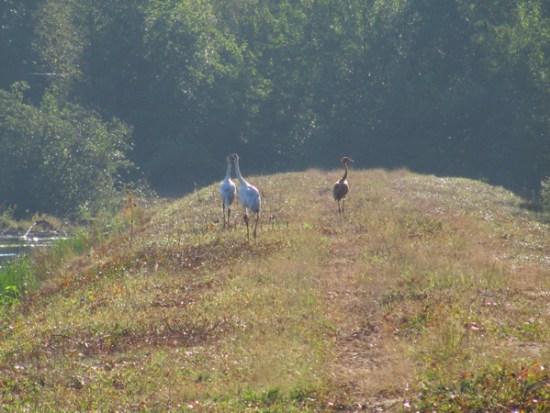
W3-10 on August 30, 2010, with parents.
October 7, 2010: Wild chick #W3-10 was captured and banded at the age of 115 days. ICF tracker Eva took photos and tells the story: “The parents remained in the cranberries, alarm calling until we were finished and their chick was returned to them. Number #W3-10 was feisty during banding and continually tried to bite and jab anything she could. “The health check showed that #W3-10 is slightly smaller in size than #W1-10, but she weighs significantly more. The two chicks are only a week apart in age. If their parents return to their previous wintering locations, both chicks will be in Florida this winter,” said Eva.
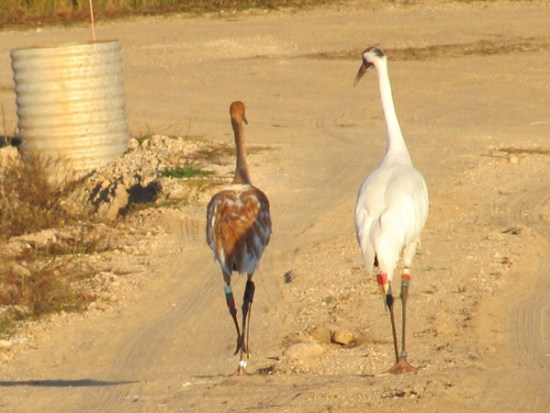
October 7, 2010: W3-10 on “banding day” with dad #12-02
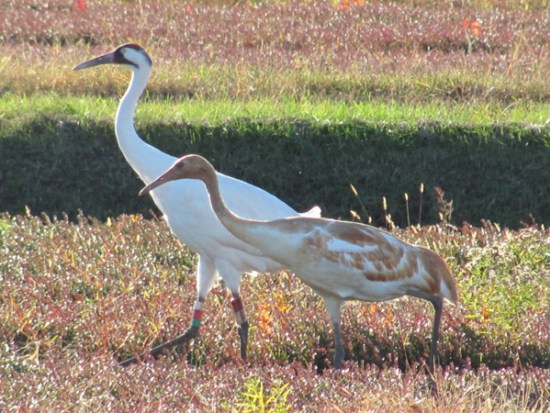
W3-10 with Dad #12-02 after being banded.
Migration History
Fall 2010: The Wood County family (#12-02, #19-04 and their chick #W3-10) began migration on November 4! They flew all the way to the parents’ regular stop in Greene County, Indiana. What an amazing day it must have been for #W3-10 as she began her first migration! She and her parents remained there until the morning of December 6. They were next found during an aerial survey on December 13 on the adults’ wintering territory in Pasco County, Florida. First migration complete! HOORAY, #W3-10!
First Winter in Florida: The young chick stayed near her parents on their wintering territory, learning their lessons in how to forage for food and keep safe. ICF tracker Eva suspects the family will be among the early northbound migrants. The pair has stopped by the Chass pen in previous years as they start their journey north. As is normal for cranes, young #W3-10 will separate from her parents either during the migration north or sometime after they arrive back in Wisconsin.
Spring 2011: #W3-10 began her first northward migration between Feb. 19 and 23 with her parents. The family was reported March 1 in Greene County, IN. They stayed at least through March 5. On the evening of March 20 the family was reported in Kane County, IL. On March 23, tracker Jen sent word: “I just heard signals of the Wood County family (#W3-10, and parents #12-02 and #19-04) over Baraboo, Wisconsin!” The family was back on their Wood County territory March 25. Two days later they moved to another location where the adults left the chick before returning to their Wood County territory. As of April 3rd, #W3-10 remained in the area she was left by her parents.
Fall 2011: #W3-10 migrated and began the winter in Knox County, Indiana and then moved to Greene County, Indiana in early January.
Spring 2012: #W3-10 was reported back on Wisconsin’s Necedah NWR on March 11, migration complete!
Fall 2012: #W3-10 wintered again in Indiana.
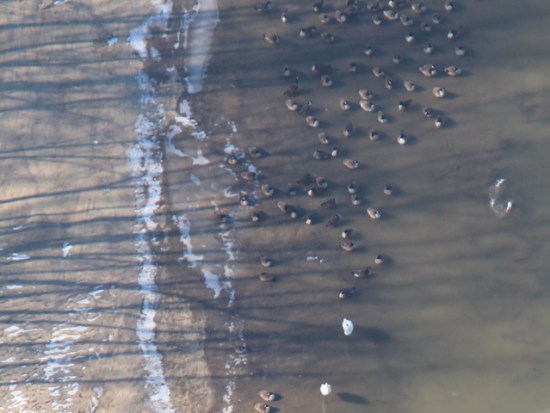
Spring 2013: Crane #W3-10 (with #29-08) completed migration by or on April 3. Very soon after, male #4-08 stole female #W3-10 away from him. Tracker Eva didn’t think #4-08 and #W3-10 would stay together, but is watching to see.
Fall 2013: Female #W3-10 and mate #29-08 migrated to Greene County, Indiana, and later moved to Knox County, IN, where they were last reported on February 2. Here they are in Daviess County, IN on Feb. 12, 2014—photographed by ICF tracker Eva on her aerial tracking flight.
Spring 2013: #W3-10 was detected back at Necedah NWR on April 5. Her mate #29-08, who has a non-working transmitter, was assumed to be with her.
Fall 2014: By November 23 pair #W3-10 and #29-08 had migrated south to Knox County, Indiana, where they joined cranes #7-12, #3-11, #24-13 and #38-09 DAR.
Spring 2015: #W3-10 and mate #29-08 successfully migrated back to Wisconsin—and had two chicks by mid May! These chicks are second-generation wild-hatched Whooping Cranes, since #W3-10 is herself wild-hatched. Unfortunately, the chicks did not survive their first month.
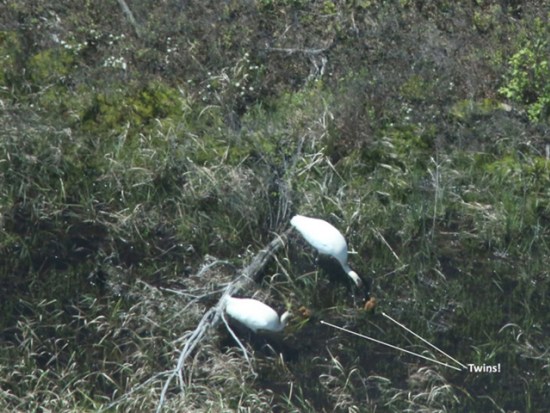
Twins! Photo: Beverly Paulan, Wisconsin DNR
Fall 2015: #W3-10 migrated to Greene County, Indiana and spent the winter associating with #8-04 and young DAR #65-15.
Spring 2016: #W3-10 returned from Indiana and paired with male #8-04 during the summer in Wisconsin. They nested and their first nest had two eggs removed as part of the forced renesting experiment. They did not build a second nest this summer.
Fall 2016: Pair #W3-10 and #8-04 were seen at Necedah NWR in early fall. The pair was reported in Greene County, Indiana the end of December.
Spring 2017: W3-10, and her mate #8-04, both with non-working transmitters, had completed migration back to the Necedah NWR by early April and were seen with a nest on Bev Paulan’s aerial survey April 11. Those eggs were collected for captive incubation in the Forced Renesting Study. They re-nested and were incubating their second nest when seen on Bev Paulan’s May 12 flight. W9-17 and W10-17 hatched about May 30. In sad news, both chicks were gone when Bev Paulan flew over the pair’s territory on June 15.
Fall 2017: In early November W3-10 and 8-04 were seen at the normal wintering area at Goose Pond, Indiana.
Spring 2018: W3-10 and 8-04 returned to Necedah NWR in April. Around May 30, chick W5-18 hatched! Unfortunately, the pair disappeared in mid-June, and the temporary transmitter that had been placed on the chick was found with just a few feathers attached. The team assumed the chick had died- which was why it was such a happy surprise when the whole family reappeared in September with a fully-fledged chick- the first chick fledged with a wild-hatched parent!
Fall 2018: In mid-October, the family group of 8-04, W3-10, and W5-18 migrated to the pair’s wintering grounds in Goose Pond, Indiana.
Spring 2019: W3-10 and 8-04 returned to Necedah NWR with their chick W5-18 by early April. W5-18 was promptly kicked out of their territory in preparation for nesting season.
W3-10 and 8-04 were first seen sitting on a nest by pilot Bev Paulan on April 16. Chicks W5-19 and W6-19 hatched around May 14, but W6-19 was not seen on Bev’s May 20 flight.
Mate 8-04 was found dead on May 31 with W3-10 and chick W5-19 nearby. Cause of death is infection. Unfortunately, without two parents to protect the chick, W5-19 was lost shortly after as well.
At the end of August, W3-10 began associating with male 7-07, who had also lost his mate during the summer.
Fall 2019: After spending the summer with new mate W3-10, the two traveled to Goose Pond for the winter. They spent the winter here among other whooping cranes.
Spring 2020: 7-07 and W3-10 were first spotted back on their territory at Necedah in mid-May. We are unsure when they arrived back and the pair may have nested, but we do not have confirmation of that. The two have spent the summer together.
Fall 2020: 7-07 and mate W3-10 left Necedah NWR but stayed in Juneau County in mid- October. They were first seen at Goose Pond FWA at the beginning of November and have been seen associating with a large group of young whooping cranes and breeding pairs.
Spring 2021: W3–10 and 7–07 migrated back North and were seen back on their territory at Necedah National Wildlife Refuge. Their nest was unfortunately unsuccessful this spring and their eggs did not hatch. Her mate, 7–07, has been recently fitted with a new satellite transmitter so the field team can see the pair’s movements in almost real time!
Fall 2021: 7-07 and mate W3-10 started their journey south on the 18th of November and flew directly over Chicago on their way to Greene County, Indiana. Once they arrived, they began associating with a large flock of young whooping cranes and breeding pairs.
Spring 2022: 7-07 and mate W3-10 were seen back on their territory in Necedah National Wildlife Refuge in late March. They began nesting soon after arrival, but the eggs from this nest were collected as part of the forced renesting program, which helps the pair avoid black flies and nest again when black flies are gone. Since then, they have been hanging around their territory in Necedah NWR.
Fall 2022: 7-07 and W3-10 spent the rest of the summer on their territory at Necedah NWR. They migrated in late October to their wintering grounds in Greene County, IN, where they are hanging out with a group of Whooping Cranes.
Spring 2023: 7-07 and W3-10 stayed in Greene County, Indiana until February when they traveled about 50 miles west to Lawrence County, Illinois. They stayed in Lawrence County until March when they returned to their breeding territory at Necedah National Wildlife Refuge to begin nesting. In May, they were incubating two fertile eggs, one of which was collected and brought back to the International Crane Foundation to be raised in captivity and released. This is a useful way to grow the population since Whooping Cranes typically only raise one chick a year. Unfortunately, their nest with the remaining egg failed, due to predation by a coyote. We are hopeful that this pair will raise a chick next year!
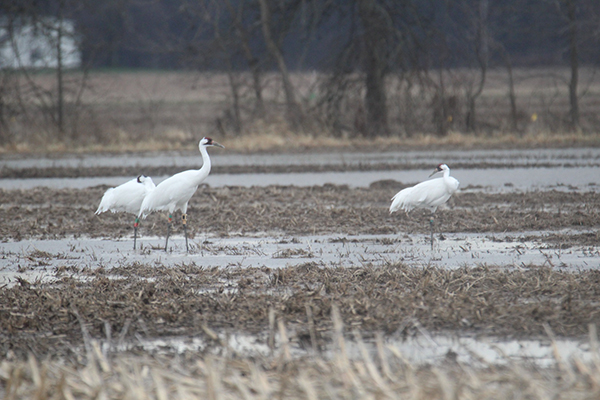
Fall 2023: W3-10 remained at Necedah NWF with her mate 7-07 for the rest of the summer, and in late October, the pair left Wisconsin and migrated to their normal wintering grounds at Goose Pond FWA in Indiana. The pair has stayed in the area throughout the winter and can often be found in a large group with the other Whooping Cranes that spend their winters at Goose Pond.
Click here to jump to the top of this page.

